Karen Lynn Allen's Blog, page 8
August 28, 2012
A Tale of Five Cities--Fascinating, Evolving Berlin

(This is the second of a five-part series. Part one is Charming,Livable Amsterdam.)
 Brandenburg Gate November 1989Berlin is a paradox. Full of history and charm, it is neither quaint nor charming in a conventional sense. It has buildings that look centuries old but, in fact, were rebuilt nearly stone for stone only a few decades ago. It is the capital of a country with one of the greatest economies in the world, and yet its streets and its people often look a disheveled, funky, scraping by. Like Rome, Berlin has so many resonating layers of history they burst through each other to claim one’s attention. There is Prussian old Berlin of the Kaisers and ambitious Bismark. There is chaotic Berlin of the twenties, rising fascist Berlin of the 30’s. There is insane warmongering Nazi Berlin, and defeated, bombed-into-rubble post-war Berlin. Occupied Berlin turns into Cold War Berlin that segues into wall-divided Berlin. This crystallizes into a Berlin dominated by the paranoid, scary, and in some ways wildly funny DDR, a James Bond villain government if there ever was one. And then we have heroic Berlin, Berlin of the wall-tearer-downers, Berlin of the jubilant Brandenburg Gate. Berlin reclaiming itself; a Berlin of unity, healing, restoration. And today a Berlin that is still reimagining and reinventing itself, greening itself, all the while shouldering its role as uber-serious fiscal leader of Europe.
Brandenburg Gate November 1989Berlin is a paradox. Full of history and charm, it is neither quaint nor charming in a conventional sense. It has buildings that look centuries old but, in fact, were rebuilt nearly stone for stone only a few decades ago. It is the capital of a country with one of the greatest economies in the world, and yet its streets and its people often look a disheveled, funky, scraping by. Like Rome, Berlin has so many resonating layers of history they burst through each other to claim one’s attention. There is Prussian old Berlin of the Kaisers and ambitious Bismark. There is chaotic Berlin of the twenties, rising fascist Berlin of the 30’s. There is insane warmongering Nazi Berlin, and defeated, bombed-into-rubble post-war Berlin. Occupied Berlin turns into Cold War Berlin that segues into wall-divided Berlin. This crystallizes into a Berlin dominated by the paranoid, scary, and in some ways wildly funny DDR, a James Bond villain government if there ever was one. And then we have heroic Berlin, Berlin of the wall-tearer-downers, Berlin of the jubilant Brandenburg Gate. Berlin reclaiming itself; a Berlin of unity, healing, restoration. And today a Berlin that is still reimagining and reinventing itself, greening itself, all the while shouldering its role as uber-serious fiscal leader of Europe.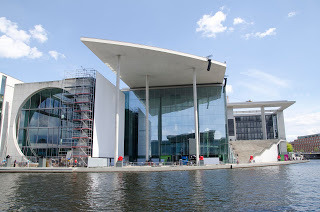 See the gleamFor one of my daughters, Berlin was her favorite of the cities we visited; for the other, it was the least. One found it modern, bustling, vibrant, its history exciting, its people lively and creative. The other found it grey, drab, gritty, its scale too big, its history too sad, its architecture too prone towards brutalism. More than anything, Berlin feels unfinished, a work in progress. The former eastern half is still being rebuilt, upgraded, repaired, a massive effort and investment. From the top of the Berlin Cathedral we could see an absolutely ridiculous number of construction cranes in operation. The banks of the Spree River host gleaming new government buildings, some with stunning architecture, most with extensive glass walls so that even major politicians can be seen lunching and conversing. (The walk along the Spree in and among these buildings is absolutely lovely.) A repaired and restored Reichstag boasts an elegant new glass cupola from which the public can gaze down at their government at work. (In theory all this glass is a symbol of the German government’s commitment to transparency.) The scale of it all, the sense that the German people are finding their stride, taking control of their destiny and finally putting their country back together the way they want it is impressive. This is not a country so divided by political dysfunction that nothing gets done. Things are happening here.
See the gleamFor one of my daughters, Berlin was her favorite of the cities we visited; for the other, it was the least. One found it modern, bustling, vibrant, its history exciting, its people lively and creative. The other found it grey, drab, gritty, its scale too big, its history too sad, its architecture too prone towards brutalism. More than anything, Berlin feels unfinished, a work in progress. The former eastern half is still being rebuilt, upgraded, repaired, a massive effort and investment. From the top of the Berlin Cathedral we could see an absolutely ridiculous number of construction cranes in operation. The banks of the Spree River host gleaming new government buildings, some with stunning architecture, most with extensive glass walls so that even major politicians can be seen lunching and conversing. (The walk along the Spree in and among these buildings is absolutely lovely.) A repaired and restored Reichstag boasts an elegant new glass cupola from which the public can gaze down at their government at work. (In theory all this glass is a symbol of the German government’s commitment to transparency.) The scale of it all, the sense that the German people are finding their stride, taking control of their destiny and finally putting their country back together the way they want it is impressive. This is not a country so divided by political dysfunction that nothing gets done. Things are happening here.But let’s back up to our entry into the land of Beethoven, sauerkraut and Euro Cup mania. Even though trains leave from Amsterdam to Berlin every other hour, our train was packed! I was very glad I reserved seats for the five of us or not only we would have been spread out among cars, we might not have had seats at all. (One Japanese tourist stood in the aisle of our car well over an hour to her destination.) The train was comfortable, but the food available for sale was surprisingly lacking. Luckily we had some fruit with us and a round of Dutch cheese. (This cheese saw us through three separate train trips.) Our train wasn’t one of the high-speed, 196 mph versions that Europe boasts. It was a cheaper, medium-speed train, humming along at only 120 mph. Practically a snail.
 See them everywhereAs we traversed Germany, I was impressed by the number of solar panels and wind turbines dotting the landscape. The solar was mostly on rooftops; the wind turbines peppered farmland. Though there were some wind turbines in the Netherlands, they were nothing compared to Germany’s. Just the ones I could see from my train window made the great California wind farms of Altamont Pass and Montezuma Hills look small. Indeed, Germany now has 29 Gigawatts (GW) of wind energy capacity installed, compared to California’s 4.3 GW. The amount of solar PV we saw was also remarkable, especially given the latitude, considerably north of the US/Canadian border. But even with their northerly location, Germany has installed close to 25 Gigawatts (GW) of solar PV compared to California’s 1 GW of the same. Together wind plus solar meet about 16% of German electricity demand, so you can see the Germans are going after renewables pedal to the metal (so to speak.) It’s interesting to compare California to Germany since California has a little less than half of Germany’s population and a bit more than half of its GDP. California is first in the US for installed solar, and third for installed wind, behind only Texas and Iowa. But although California is ostensibly wealthier per capita than Germany, we’ve made only one-tenth the investment in solar and wind.
See them everywhereAs we traversed Germany, I was impressed by the number of solar panels and wind turbines dotting the landscape. The solar was mostly on rooftops; the wind turbines peppered farmland. Though there were some wind turbines in the Netherlands, they were nothing compared to Germany’s. Just the ones I could see from my train window made the great California wind farms of Altamont Pass and Montezuma Hills look small. Indeed, Germany now has 29 Gigawatts (GW) of wind energy capacity installed, compared to California’s 4.3 GW. The amount of solar PV we saw was also remarkable, especially given the latitude, considerably north of the US/Canadian border. But even with their northerly location, Germany has installed close to 25 Gigawatts (GW) of solar PV compared to California’s 1 GW of the same. Together wind plus solar meet about 16% of German electricity demand, so you can see the Germans are going after renewables pedal to the metal (so to speak.) It’s interesting to compare California to Germany since California has a little less than half of Germany’s population and a bit more than half of its GDP. California is first in the US for installed solar, and third for installed wind, behind only Texas and Iowa. But although California is ostensibly wealthier per capita than Germany, we’ve made only one-tenth the investment in solar and wind. 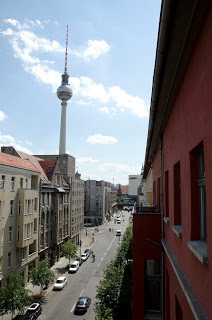 Our viewAfter crossing almost to the eastern edge of Germany, we finally arrived in Berlin. Our apartment was near Alexanderplatz, right in the center of the city. In fact, our apartment had a balcony terrace with a view of the crazy TV tower left over from the sixties (1969, to be exact) when so many cities felt the need to put up groovy, space-age constructs reaching toward the sky. Our apartment was five floors up and involved a lot of stairs. (Luckily, we are used to stairs where we live.) I found it pleasant to have an outdoor space, however small, to drink a cup of tea in the morning or look out at the city lights in the evening. It made the apartment more airy, more connected to the neighborhood and the natural world. I would go so far as to say having some small amount of outdoor living space is connected to psychological health.
Our viewAfter crossing almost to the eastern edge of Germany, we finally arrived in Berlin. Our apartment was near Alexanderplatz, right in the center of the city. In fact, our apartment had a balcony terrace with a view of the crazy TV tower left over from the sixties (1969, to be exact) when so many cities felt the need to put up groovy, space-age constructs reaching toward the sky. Our apartment was five floors up and involved a lot of stairs. (Luckily, we are used to stairs where we live.) I found it pleasant to have an outdoor space, however small, to drink a cup of tea in the morning or look out at the city lights in the evening. It made the apartment more airy, more connected to the neighborhood and the natural world. I would go so far as to say having some small amount of outdoor living space is connected to psychological health.Berlin is essentially a former East German city surrounded by former East German suburbs, and the fortunes of Berlin today reflect this historical fact. Even though Berlin is Germany’s capital and its largest city, its unemployment rate is double Germany’s as a whole and its GDP per capita is 16% less. This makes for a city that is both run-down and vibrant, energetic but also oddly tranquil.
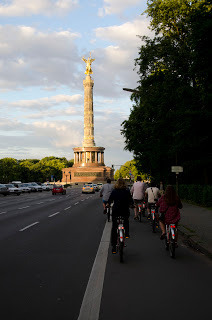 Biking in BerlinOne source of tranquility for this dense city of 3.5 million was surprising: in the capital of one of the world’s greatest car manufacturers, there just weren’t a whole lot of cars on the streets. In fact, the rate of car ownership in Berlin is lower than every other major city in Europe. (Even lower than Amsterdam.) Half of all Berlin households do not own a car. In the area of town we stayed in, the Mitte, most buildings were six stories high, with shops and businesses on the ground floor and residential above. The public transportation in Berlin is extensive. There is the U-Bahn (underground), the S-Bahn (mostly elevated but some underground) and trams and buses. There are not THE BICYCLES of Amsterdam, but there are still twice as many bicycles in Berlin as cars. And not only do people in Berlin not own cars, they don’t drive them much when they do have them. In the US two thirds of trips under a mile are made by car compared to one third of such trips in Germany. In the Mitte, 13% of trips are made by bicycle, 30% by walking, 29% by public transit, and only 22% by private vehicle. This makes the private vehicle use roughly half that of San Francisco. The even more surprising part is that congestion is not linear: halving the number of cars reduces congestion to the point that the Mitte “feels” like it has only a fourth of San Francisco’s traffic. In addition, three fourths of Berlin’s streets have a 30 km per hour (18mph) speed limit. This may sound horribly limiting, but when you combine this speed with car-lite streets, car drivers actually get places faster than in American cities because there is so little congestion.
Biking in BerlinOne source of tranquility for this dense city of 3.5 million was surprising: in the capital of one of the world’s greatest car manufacturers, there just weren’t a whole lot of cars on the streets. In fact, the rate of car ownership in Berlin is lower than every other major city in Europe. (Even lower than Amsterdam.) Half of all Berlin households do not own a car. In the area of town we stayed in, the Mitte, most buildings were six stories high, with shops and businesses on the ground floor and residential above. The public transportation in Berlin is extensive. There is the U-Bahn (underground), the S-Bahn (mostly elevated but some underground) and trams and buses. There are not THE BICYCLES of Amsterdam, but there are still twice as many bicycles in Berlin as cars. And not only do people in Berlin not own cars, they don’t drive them much when they do have them. In the US two thirds of trips under a mile are made by car compared to one third of such trips in Germany. In the Mitte, 13% of trips are made by bicycle, 30% by walking, 29% by public transit, and only 22% by private vehicle. This makes the private vehicle use roughly half that of San Francisco. The even more surprising part is that congestion is not linear: halving the number of cars reduces congestion to the point that the Mitte “feels” like it has only a fourth of San Francisco’s traffic. In addition, three fourths of Berlin’s streets have a 30 km per hour (18mph) speed limit. This may sound horribly limiting, but when you combine this speed with car-lite streets, car drivers actually get places faster than in American cities because there is so little congestion.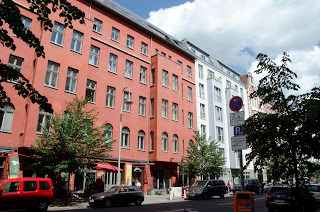 Tranquil Mitte neighborhoodThe car-lite streets combined with the low speed limits makes the Mitte area, even though densely populated, very livable. Low noise, low pollution, few vibrations. Pleasant for outdoor cafes; safe and easy to cross the street. Safe and easy to bicycle. On the whole the bicycle infrastructure I saw in Berlin ranged from pretty good to inadequate, much better than San Francisco but generally nowhere near as good as Amsterdam. However, because so many streets are so calm with just sporadic, slow-moving cars, bicycles sharing the road with cars on these streets isn’t so bad. The injury and death rates for pedestrians and bicyclists in Germany are a fraction of ours in the US. On the street we were staying, one with shops and many lively restaurants, probably only one car passed by a minute. Three times that number of bicycles and six times that number of pedestrians passed by in the same time frame. Just as a note, people tend to have nicer bikes in the Mitte than in Amsterdam. Part of this might be due to people storing their bicycles at night in the interior courtyards of their apartment buildings rather than out on the street.
Tranquil Mitte neighborhoodThe car-lite streets combined with the low speed limits makes the Mitte area, even though densely populated, very livable. Low noise, low pollution, few vibrations. Pleasant for outdoor cafes; safe and easy to cross the street. Safe and easy to bicycle. On the whole the bicycle infrastructure I saw in Berlin ranged from pretty good to inadequate, much better than San Francisco but generally nowhere near as good as Amsterdam. However, because so many streets are so calm with just sporadic, slow-moving cars, bicycles sharing the road with cars on these streets isn’t so bad. The injury and death rates for pedestrians and bicyclists in Germany are a fraction of ours in the US. On the street we were staying, one with shops and many lively restaurants, probably only one car passed by a minute. Three times that number of bicycles and six times that number of pedestrians passed by in the same time frame. Just as a note, people tend to have nicer bikes in the Mitte than in Amsterdam. Part of this might be due to people storing their bicycles at night in the interior courtyards of their apartment buildings rather than out on the street.Low car ownership levels might be due to Berlin’s high unemployment and relative poverty, at least in relation to the western parts of their country. It might be due to West Berlin and East Berlin spending several decades competing with each other as to who could provide better public transportation. It might be due to Berlin being flat and easy to bicycle around, although Berlin does get its fair share of rain and snow. It might be due to decent levels of fitness that makes walking fifteen minutes to get somewhere both practical and effortless for most people. It might be due to expensive parking; it might be due to people from the suburbs taking the excellent train network into the city rather than their cars. Infrastructure, habits, attitudes, years of investment, and car-lite government policies all add up.
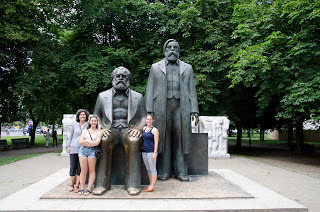 Dozens of Chinese tourists wanted this shot (Marx and Engels)Right after settling into our apartment we went to the base of the crazy TV tower where we met up with our bicycle tour. Our guide was a British woman with a half-shaved head who absolutely adored Berlin and its history. She sure knew her stuff. As usual with a bicycle tour, we were able to cover days of sightseeing in four and a half hours, and this included wending our way through masses of drunken, singing football (soccer) fans, competing with hordes of Chinese tourists for photo opportunities, and a stop at a beer garden in the lovely woods of the Tiergarten. The tour covered many WWII and Cold War highlights. What was interesting was how the city itself appeared to celebrate the Cold War (and its eventual jubilant end) and played down WWII. One history is sung, the other mumbled. Perhaps, on reflection, this is not so surprising.
Dozens of Chinese tourists wanted this shot (Marx and Engels)Right after settling into our apartment we went to the base of the crazy TV tower where we met up with our bicycle tour. Our guide was a British woman with a half-shaved head who absolutely adored Berlin and its history. She sure knew her stuff. As usual with a bicycle tour, we were able to cover days of sightseeing in four and a half hours, and this included wending our way through masses of drunken, singing football (soccer) fans, competing with hordes of Chinese tourists for photo opportunities, and a stop at a beer garden in the lovely woods of the Tiergarten. The tour covered many WWII and Cold War highlights. What was interesting was how the city itself appeared to celebrate the Cold War (and its eventual jubilant end) and played down WWII. One history is sung, the other mumbled. Perhaps, on reflection, this is not so surprising.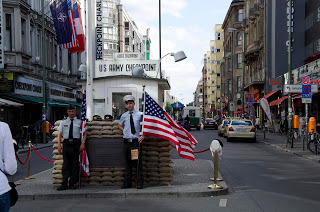 The happy historyAs the Russians and Germans fought through Berlin block by bitter block in April and early May of 1945, the city was pretty much bombed to rubble. When the war was over, anything left of the grand Nazi architecture was hurriedly obliterated. One of the few buildings intact from that grandiose era is the former Luftwaffe headquarters. Hitler’s New Reich Chancellery, built in one year by 4000 workers staffed round the clock, is no more, demolished by the Soviets, its blood-red marble carted away. On top of the bunker where Hitler spent his last days is merely a gravel parking lot. Not even a marker indicates what lurks beneath, but it’s all still down there, just bulldozed over. While Checkpoint Charlie has cheery actors in American and Soviet uniforms, and segments of the Berlin Wall are displayed around the city like public art, reminders of what preceded Berlin’s sad division are few. Maybe this is good; maybe neo-Nazis would just use Hitler’s bunker or palace as a shrine of adulation, but still it feels almost as if the Nazis have been photo-shopped out of the picture. Even the word “Hitler” has gained Voldemort-like unmentionable status. Given that Berlin is rife with twentieth-century history, we discussed the various eras and events with our kids, doing our best to make a distinction between the Nazis and the German people. However, in restaurants and on the U-Bahn, we soon learned to speak in undertones or in code when mentioning Hitler. Uncomfortable looks got sent our way otherwise.
The happy historyAs the Russians and Germans fought through Berlin block by bitter block in April and early May of 1945, the city was pretty much bombed to rubble. When the war was over, anything left of the grand Nazi architecture was hurriedly obliterated. One of the few buildings intact from that grandiose era is the former Luftwaffe headquarters. Hitler’s New Reich Chancellery, built in one year by 4000 workers staffed round the clock, is no more, demolished by the Soviets, its blood-red marble carted away. On top of the bunker where Hitler spent his last days is merely a gravel parking lot. Not even a marker indicates what lurks beneath, but it’s all still down there, just bulldozed over. While Checkpoint Charlie has cheery actors in American and Soviet uniforms, and segments of the Berlin Wall are displayed around the city like public art, reminders of what preceded Berlin’s sad division are few. Maybe this is good; maybe neo-Nazis would just use Hitler’s bunker or palace as a shrine of adulation, but still it feels almost as if the Nazis have been photo-shopped out of the picture. Even the word “Hitler” has gained Voldemort-like unmentionable status. Given that Berlin is rife with twentieth-century history, we discussed the various eras and events with our kids, doing our best to make a distinction between the Nazis and the German people. However, in restaurants and on the U-Bahn, we soon learned to speak in undertones or in code when mentioning Hitler. Uncomfortable looks got sent our way otherwise.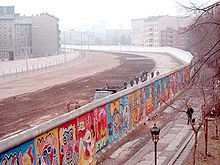 Some wounds leave scarsBut the Cold War is visible in Berlin in spades, not only in relics and museums (the DDR museum manages to be both nostalgic and a hysterically sarcastic examination of Berlin’s cold war era) but in the physical scar still left by the Wall. The Wall itself wasn’t all that thick, but it included a no-man’s land that cut a swath through the city up to a hundred yards wide and 27 miles long. Berlin is still trying to figure out what to do with the space. Some want it eradicated as fast as possible to facilitate unity and healing; others see it as a creative void, allowing impromptu activities and events that are themselves monuments to freedom. Around the Brandenburg Gate the scar was easy to erase, just reinstate a great plaza that, while we were there, was filled with giant screens for the public to watch the Euro Cup competition, courtesy of Hyundai. (A Korean car company? Really?) Poor Brandenburg Gate, standing forlorn in the midst of barbed wire for so many years. I can imagine the exultation Berliners of both side must have felt to get it back. While many parts of the Wall’s scar have been filled, much remains, mutely reminding Berlin about its past and simultaneously raising questions about its future.
Some wounds leave scarsBut the Cold War is visible in Berlin in spades, not only in relics and museums (the DDR museum manages to be both nostalgic and a hysterically sarcastic examination of Berlin’s cold war era) but in the physical scar still left by the Wall. The Wall itself wasn’t all that thick, but it included a no-man’s land that cut a swath through the city up to a hundred yards wide and 27 miles long. Berlin is still trying to figure out what to do with the space. Some want it eradicated as fast as possible to facilitate unity and healing; others see it as a creative void, allowing impromptu activities and events that are themselves monuments to freedom. Around the Brandenburg Gate the scar was easy to erase, just reinstate a great plaza that, while we were there, was filled with giant screens for the public to watch the Euro Cup competition, courtesy of Hyundai. (A Korean car company? Really?) Poor Brandenburg Gate, standing forlorn in the midst of barbed wire for so many years. I can imagine the exultation Berliners of both side must have felt to get it back. While many parts of the Wall’s scar have been filled, much remains, mutely reminding Berlin about its past and simultaneously raising questions about its future. 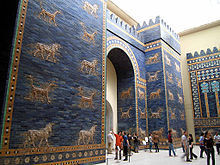 A serious gateA simply amazing place in Berlin is the Pergamon Museum. For some reason, before I began researching our trip, I had never heard of it. I don’t know how this is possible. It’s like not knowing about the British Museum. Back at the turn of the century, when every wealthy colonial power wanted to show off its cultural prowess by carting off the remains of some ancient civilization, the Germans went gung ho in what is now Turkey and Iraq. They dug up some absolutely amazing stuff and brought it all back to Berlin, apparently without a twinge of conscience because everyone knew only northern Europeans could appreciate ancient cultures. So the Pergamon Museum now houses Babylon’s (yes, thatBabylon) absolutely enormous Gate of Ishtar, one of the seven wonders of the ancient world until the Lighthouse in Alexandria booted it off the list in the 6th century AD. Evidently what’s in the museum is just the small, frontal part of the gate. The big kahuna back part was deemed too large and is in storage. (Heck, just the front is nearly five stories high.) The Pergamon Museum is also home to (and named after) the great Pergamon Altar, a prized example of Hellenic art and architecture. It was reconstructed in its entirety so that today we can walk up and down its steps and pretend we live two millennia ago in the Pergamene Kingdom. And there is the Market Gate of Miletus, perhaps my favorite exhibit at the Pergamon. The history of Miletus (located, like Pergamon, in what is now Turkey) begins in the mists of the Bronze Age. After several incarnations it eventually wound up as an Ionian Greek city and produced philosophers, writers, architects, even urban planners. Miletus must’ve prospered because the Market Gate dates from the second century AD and reflects Roman rather than Hellenistic design. The gate was shaken down by an earthquake around 1100 AD and then waited eight centuries for the Germans to put it back together like Humpty Dumpty. If I could be a time tourist, I would visit its crumbling, magnificent ruins just before that quake.
A serious gateA simply amazing place in Berlin is the Pergamon Museum. For some reason, before I began researching our trip, I had never heard of it. I don’t know how this is possible. It’s like not knowing about the British Museum. Back at the turn of the century, when every wealthy colonial power wanted to show off its cultural prowess by carting off the remains of some ancient civilization, the Germans went gung ho in what is now Turkey and Iraq. They dug up some absolutely amazing stuff and brought it all back to Berlin, apparently without a twinge of conscience because everyone knew only northern Europeans could appreciate ancient cultures. So the Pergamon Museum now houses Babylon’s (yes, thatBabylon) absolutely enormous Gate of Ishtar, one of the seven wonders of the ancient world until the Lighthouse in Alexandria booted it off the list in the 6th century AD. Evidently what’s in the museum is just the small, frontal part of the gate. The big kahuna back part was deemed too large and is in storage. (Heck, just the front is nearly five stories high.) The Pergamon Museum is also home to (and named after) the great Pergamon Altar, a prized example of Hellenic art and architecture. It was reconstructed in its entirety so that today we can walk up and down its steps and pretend we live two millennia ago in the Pergamene Kingdom. And there is the Market Gate of Miletus, perhaps my favorite exhibit at the Pergamon. The history of Miletus (located, like Pergamon, in what is now Turkey) begins in the mists of the Bronze Age. After several incarnations it eventually wound up as an Ionian Greek city and produced philosophers, writers, architects, even urban planners. Miletus must’ve prospered because the Market Gate dates from the second century AD and reflects Roman rather than Hellenistic design. The gate was shaken down by an earthquake around 1100 AD and then waited eight centuries for the Germans to put it back together like Humpty Dumpty. If I could be a time tourist, I would visit its crumbling, magnificent ruins just before that quake.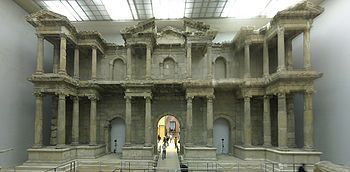 Miletus, put back together
Miletus, put back together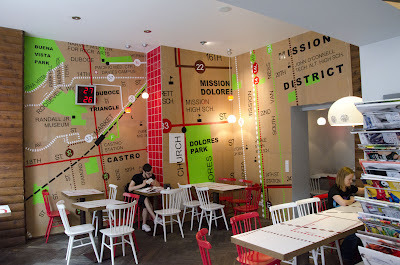 Imagine our surpriseBut ancient treasures are not the only surprises in Berlin. A block from our apartment, we saw a restaurant sign that curiously said, “Dolores.” Well, that didn’t sound German. Peeking our heads in, we saw a map of our San Francisco neighborhood spread out larger than life on the wall! It turns out Dolores is a well-reviewed gourmet burrito place that pays tribute to San Francisco. Of course we ate lunch there, and while the burritos aren’t exactly the same as the ones in the Mission, they were quite tasty. I suppose if they’d named themselves “Valencia,” that would’ve been even more hipster cool, but next time you’re in Berln, I say check them out.
Imagine our surpriseBut ancient treasures are not the only surprises in Berlin. A block from our apartment, we saw a restaurant sign that curiously said, “Dolores.” Well, that didn’t sound German. Peeking our heads in, we saw a map of our San Francisco neighborhood spread out larger than life on the wall! It turns out Dolores is a well-reviewed gourmet burrito place that pays tribute to San Francisco. Of course we ate lunch there, and while the burritos aren’t exactly the same as the ones in the Mission, they were quite tasty. I suppose if they’d named themselves “Valencia,” that would’ve been even more hipster cool, but next time you’re in Berln, I say check them out.  Furnish your apartment
Furnish your apartment
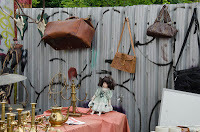 Flea Market finds
Flea Market findsWhen you’ve had your burrito and really want to fill your hipster quota, the flea market next to the Mauerpark, (literally “Wall Park,” because it was created from a stretch of Wall scar) is the place to go. You can even take the U-Bahn to get there! By our third day in Berlin, after all the museums and culture Mom tried to cram down her throat, youngest daughter was longing for Shopping. Now Mom is not much of a Shopper and isn’t particularly inclined to spend vacation time on the activity. But many museums had indisputably been entered, and a compromise was in order. The Mauerpark flea market turned out to be not only a Shopping Delight to younger daughter, it was also enough of a Cultural Excursion to placate Mom. (Other family members shopped or appreciated cultural niceties in varying degrees.) In addition, it was very Good Value, pleasing to mother and daughter alike. At the Mauerpark market you could outfit an entire apartment, down to the kitchen appliances. You could dress yourself and three thousand of your closest friends, outfit half the bands at Woodstock with instruments, eat a dozen different ethnic foods, buy communist memorabilia (real and fake), obtain a flotilla of marginally working typewriters--it was all there in the run-down but friendly and comfortable splendor of Mauerpark market’s vast acres. As you leave you might even be greeted by a local, scrap-iron robot like we were.
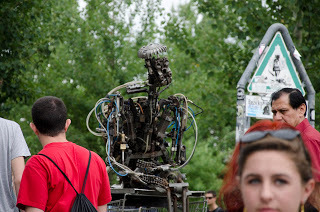
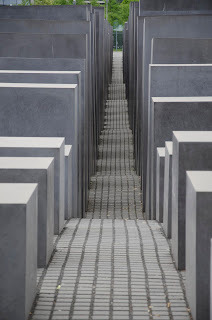 Path among stelaeAnother way Berlin has filled its Wall scar is with the extraordinary new Holocaust Memorial, inaugurated in 2005. Designed by American architect Peter Eisenman, it goes even further than the Vietnam Memorial in Washington as an interactive way not only to honor the dead, not only to feel and grieve the loss, but, in this case, to actually comprehend some of the alienation, fear and disorientation that was endemic to this dreadful period of time. First off, the memorial is huge, covering more than four acres. It is made up of stelae (large rectangular stones) placed on end in a grid pattern. But the ground is not flat; it slopes and rolls in waves. The stelae are not straight either, but rather cant like headstones in an old cemetery. Walking through the tall sections, you can only see straight ahead or straight to the side. The sky above feels a long ways away. Though you know can always walk out, you have no idea where your family members have gotten to. The hundreds of people traversing the paths with you appear and disappear between these massive stones in the blink of an eye. You feel oddly alone. Distances seem long, never-ending. And you begin to wonder what it would feel like to be split from your family, loaded in a rail car, nothing familiar, nothing secure, to a fate unknown. These acres of grey stelae form a maze of Kafkaesque surrealism, a cemetery of broken dreams. To wander here is to be Alice fallen down the rabbit hole into a terminally grey, merciless world. I recommend it.
Path among stelaeAnother way Berlin has filled its Wall scar is with the extraordinary new Holocaust Memorial, inaugurated in 2005. Designed by American architect Peter Eisenman, it goes even further than the Vietnam Memorial in Washington as an interactive way not only to honor the dead, not only to feel and grieve the loss, but, in this case, to actually comprehend some of the alienation, fear and disorientation that was endemic to this dreadful period of time. First off, the memorial is huge, covering more than four acres. It is made up of stelae (large rectangular stones) placed on end in a grid pattern. But the ground is not flat; it slopes and rolls in waves. The stelae are not straight either, but rather cant like headstones in an old cemetery. Walking through the tall sections, you can only see straight ahead or straight to the side. The sky above feels a long ways away. Though you know can always walk out, you have no idea where your family members have gotten to. The hundreds of people traversing the paths with you appear and disappear between these massive stones in the blink of an eye. You feel oddly alone. Distances seem long, never-ending. And you begin to wonder what it would feel like to be split from your family, loaded in a rail car, nothing familiar, nothing secure, to a fate unknown. These acres of grey stelae form a maze of Kafkaesque surrealism, a cemetery of broken dreams. To wander here is to be Alice fallen down the rabbit hole into a terminally grey, merciless world. I recommend it. What I don’t recommend is this: while grabbing a bite to eat near the Brandenburg Gate at food stands set up for the Euro Cup viewing, do not, I repeat, do not order the currywurst. Unless, indeed, an indifferent hot dog glopped with some tasteless brown sauce and sprinkled with some sorry curry power shaken directly from a cardboard box sounds like your idea of an appetizing meal. I didn’t like it much as I ate it, and I liked it even less the next few hours that followed. In fact, I can’t understand how anyone would like it, especially given the excellent traditional German food we had at the beer garden the previous evening. In general I liked the food in Berlin. In general I made smart choices on the cuisine front—after all, I was smart enough to avoid the sushi sold on the U-Bahn subway platforms. (Someone is going to buy sushi there? Really?) But let me tell you, in the future I will avoid currywurst like the plague. As we were leaving Berlin and I was trying to decipher which platform our train was leaving from (a task not entirely stress-free given my scant ability to read German) my son said it was too bad we didn’t have time to visit the Currywurst Museum this trip. I gave him a dirty look, my family at that point being well acquainted with my currywurst debacle. My son said, “No, really! Didn’t you see the ad for it back there?” I thought he was seriously trying to annoy me, but I went over to where he pointed. No doubt he was indeed trying to annoy me, but he was also telling the truth. There was a sign with a freaking chopped-up hotdog with a face that said CURRYWURST MUSEUM. Here is a video about the place. Click on it and watch it. I’m not kidding. Watch it to the end. It is 2 minutes and 30 seconds of insane evil German satire. The people who made it are rolling on the floor laughing even now. It is the only explanation I have because no one in their right mind would CREATE A WHOLE MUSEUM ABOUT CURRYWURST. Honestly, I’m going to have to go back to Berlin just to see if this museum actually exists. If it does, I may weep.
What I don’t recommend is this: while grabbing a bite to eat near the Brandenburg Gate at food stands set up for the Euro Cup viewing, do not, I repeat, do not order the currywurst. Unless, indeed, an indifferent hot dog glopped with some tasteless brown sauce and sprinkled with some sorry curry power shaken directly from a cardboard box sounds like your idea of an appetizing meal. I didn’t like it much as I ate it, and I liked it even less the next few hours that followed. In fact, I can’t understand how anyone would like it, especially given the excellent traditional German food we had at the beer garden the previous evening. In general I liked the food in Berlin. In general I made smart choices on the cuisine front—after all, I was smart enough to avoid the sushi sold on the U-Bahn subway platforms. (Someone is going to buy sushi there? Really?) But let me tell you, in the future I will avoid currywurst like the plague. As we were leaving Berlin and I was trying to decipher which platform our train was leaving from (a task not entirely stress-free given my scant ability to read German) my son said it was too bad we didn’t have time to visit the Currywurst Museum this trip. I gave him a dirty look, my family at that point being well acquainted with my currywurst debacle. My son said, “No, really! Didn’t you see the ad for it back there?” I thought he was seriously trying to annoy me, but I went over to where he pointed. No doubt he was indeed trying to annoy me, but he was also telling the truth. There was a sign with a freaking chopped-up hotdog with a face that said CURRYWURST MUSEUM. Here is a video about the place. Click on it and watch it. I’m not kidding. Watch it to the end. It is 2 minutes and 30 seconds of insane evil German satire. The people who made it are rolling on the floor laughing even now. It is the only explanation I have because no one in their right mind would CREATE A WHOLE MUSEUM ABOUT CURRYWURST. Honestly, I’m going to have to go back to Berlin just to see if this museum actually exists. If it does, I may weep. Ein BerlinerNote: “Ich bich ein Berliner” means both “I am one with the people of Berlin” and “I am a jelly doughnut.” However, it’s an urban legend that Kennedy gaffed with the latter because his audience would have known he was saying the former. Or so I’m told.
Ein BerlinerNote: “Ich bich ein Berliner” means both “I am one with the people of Berlin” and “I am a jelly doughnut.” However, it’s an urban legend that Kennedy gaffed with the latter because his audience would have known he was saying the former. Or so I’m told. Next stop: "Sparkling, Technicolor Prague"
Published on August 28, 2012 23:05
August 13, 2012
A Tale of Five Cities--Charming, Livable Amsterdam
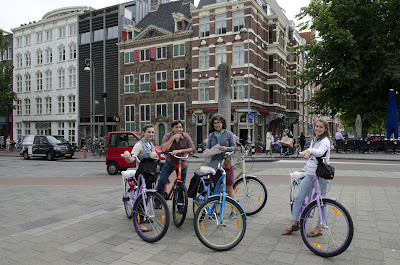
Earlier this summer my family visited five European cities: Amsterdam, Berlin, Prague, Vienna and Venice. We chose in advance not to rent a car and instead used the myriad other transportation options available in Europe. We walked and biked. We rode street-level trams, elevated light rail, underground metros, and electric passenger trains between cities. We were transported by horse-drawn carriage, water buses and a gondola. In Berlin we even rode an octo-bike (actually only a septo-bike, but the experience was not unlike riding an octopus.)
Each of these cities was amazing and delightful in its own way, but there were remarkable differences beyond the cuisine and languages spoken. In Amsterdam, seventy year olds smoked past us on their bicycles; in Venice I learned you cannot get any kind of coffee to go to save your life. In Berlin, I saw my San Francisco neighborhood plastered on a restaurant wall; in Vienna I was surprised to discover perhaps the most innovatively green city in Europe. On the downside, I learned to never ever order currywurst or rent a bike with coaster brakes again. (Some things you have to just chalk up to experience.) Come and savor my trip with me, with a special emphasis on transportation and city livability. Of course four days in a city does not an expert make, but things I observed that surprised me may surprise you, too.
In this post, I’ll tackle the first city we visited—Amsterdam.
Of course being an avid fan of bicycles—and Amsterdam being a Mecca for all things bicycle--I was looking forward tremendously to my first trip ever here. But even with the reading I’d done, I was unprepared for what I found. First off, Amsterdam is much older and more charming than I expected. I don’t know why, but I imagined it to be harsh and modern. No, no, no! Amsterdam of canals and cafes and bridges and small streets is anything but that. And for an entry point to Europe, it is superb for dipping one’s linguistic toes. Though signs and names of places are in Dutch, pretty much everyone speaks excellent English. Easy-peasy for asking questions and getting around. Communication would grow more challenging as our trip progressed.
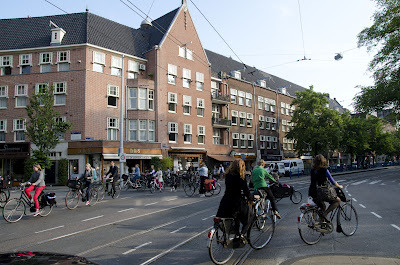 Intersection near our apartmentNext off, though of course I knew of the bicycles, I didn’t really understand THE BICYCLES in Amsterdam. The word “ubiquitous” might have been invented just for them. They are everywhere, either in motion or parked on the street. What I also didn’t expect is that for the newbie, riding a bicycle in Amsterdam alternates between unsettling and terrifying, at least for the first couple days. It got better by the third day, and I realize it was due to not being used to how the Dutch do things, but still, even with all our years of experience riding in San Francisco, and even with all the good Dutch separated bicycle infrastructure, Amsterdam was not for the uninitiated faint of heart. I suppose it is akin to taking someone who has only ever driven on the back roads of Wyoming and plopping them behind the wheel in downtown San Francisco. Eventually the person would learn to cope, but the first few days would be hairy.
Intersection near our apartmentNext off, though of course I knew of the bicycles, I didn’t really understand THE BICYCLES in Amsterdam. The word “ubiquitous” might have been invented just for them. They are everywhere, either in motion or parked on the street. What I also didn’t expect is that for the newbie, riding a bicycle in Amsterdam alternates between unsettling and terrifying, at least for the first couple days. It got better by the third day, and I realize it was due to not being used to how the Dutch do things, but still, even with all our years of experience riding in San Francisco, and even with all the good Dutch separated bicycle infrastructure, Amsterdam was not for the uninitiated faint of heart. I suppose it is akin to taking someone who has only ever driven on the back roads of Wyoming and plopping them behind the wheel in downtown San Francisco. Eventually the person would learn to cope, but the first few days would be hairy.I am a big believer in bicycle tours as a way to get acquainted with a city. On a bicycle with a guide you can cover in half a day what takes two days to see on foot. Since my husband and son were arriving a day after us, my daughters and I took a four-hour city tour of Amsterdam that covered the usual tourist high points with some history, humor and city mythology thrown in for good measure. The biking was a little dicey here and there, but our guide took care of us and got our group of thirteen around town in one piece without too much trauma. At the end of the tour, my girls and I gulped and bravely decided to rent bikes to take on our own for a few days. Then things got interesting.
First off our bikes, while relatively shiny and new, weren’t great. They had coaster brakes. (Never again.) The steering was far from nimble and it was hard to go much faster than a mild glide. I longed for my bike back in San Francisco. And since we were completely new to Amsterdam, we were the proverbial clueless tourists, constantly consulting a map. (Indeed, over half of the pictures taken of me during this entire trip in Europe show moi, family navigator, map in hand.) Still, the next day we were able to bike to the museums and all around town to show my son and husband what we’d seen on our tour the day before.
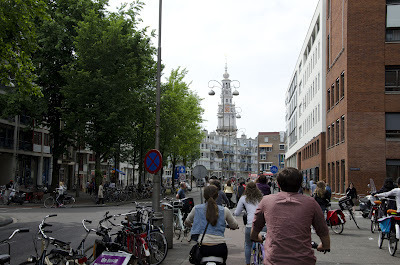 Separated from carsThough the bike lanes were almost always wide enough to ride two abreast, we mostly rode in single file to allow the locals to fly past us, even the sixty and seventy year olds. (These people are good at biking! It pays to start young and do it your whole life.) As far as I could tell, there are no stop signs in Amsterdam. I didn’t see one. There are intersections controlled by stoplights, which sometimes have a separate light for bikes and sometimes don’t, and sometimes have two parts and sometimes don’t. (Were we sometimes confused? Yes.) There are completely uncontrolled intersections (especially in the inner ring area.) And there is yielding when minor roads meet major ones. Because there are few cars in the inner ring area with its narrow streets and lovely 17th century buildings, the uncontrolled intersections here primarily involve bikes, although cars traveling slowly are definitely in the mix. But the bikes are incredible. Everyone just goes, and somehow no one hits each other. At first we would stop and try to find a gap in passing traffic. What noobs. Then we just started biking with faith no one would hit us. And no one did. It all just mysteriously works. (It helps that while Amsterdamers don’t poke along by any means, they usually ride under 15 mph and are extremely adept at judging other bicycles’ speeds and swerving accordingly.) The one thing that didn’t work for me were the motorbikes and Vespas allowed to use the bike lanes. Noisy, smelly nasty things that could just as well drive with the cars since the cars didn’t go any faster than they did.
Separated from carsThough the bike lanes were almost always wide enough to ride two abreast, we mostly rode in single file to allow the locals to fly past us, even the sixty and seventy year olds. (These people are good at biking! It pays to start young and do it your whole life.) As far as I could tell, there are no stop signs in Amsterdam. I didn’t see one. There are intersections controlled by stoplights, which sometimes have a separate light for bikes and sometimes don’t, and sometimes have two parts and sometimes don’t. (Were we sometimes confused? Yes.) There are completely uncontrolled intersections (especially in the inner ring area.) And there is yielding when minor roads meet major ones. Because there are few cars in the inner ring area with its narrow streets and lovely 17th century buildings, the uncontrolled intersections here primarily involve bikes, although cars traveling slowly are definitely in the mix. But the bikes are incredible. Everyone just goes, and somehow no one hits each other. At first we would stop and try to find a gap in passing traffic. What noobs. Then we just started biking with faith no one would hit us. And no one did. It all just mysteriously works. (It helps that while Amsterdamers don’t poke along by any means, they usually ride under 15 mph and are extremely adept at judging other bicycles’ speeds and swerving accordingly.) The one thing that didn’t work for me were the motorbikes and Vespas allowed to use the bike lanes. Noisy, smelly nasty things that could just as well drive with the cars since the cars didn’t go any faster than they did.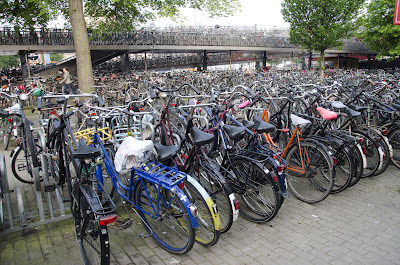 A gazillion bikes at the central train stationOutside of the inner ring area, when riding the mix of minor and major roads, I observed that the minor roads have very few cars, rendering them for the most part quite tranquil. Transitioning from a minor onto a major road in a car required some care. Cars often had to cross a distinct raised area separate in style and color from the road and first yield to pedestrians, then to bikes, and then could make a turn (or, heaven forbid, go straight across) when a gap in car traffic appeared. The cars were very good about yielding in these situations. I didn’t see even one try to push its nose through a mess of pedestrians or bikes. In fact, if you were a bike on a major road approaching a car on a minor one, you could be confident they would see you and wait for you to pass. The only times I felt threatened by cars in Amsterdam were on the narrow inner ring roads adjacent to the canals where there was not room to pass however much we tried to hug the right-hand side. (Door zone!) Though there were few cars on these roads, the ones that were there would hang behind impatiently and squeeze past the second they had the chance. One car came so close its mirror actually knocked my handlebar. (I was indignant. This was Amsterdam—land of pure biking!)
A gazillion bikes at the central train stationOutside of the inner ring area, when riding the mix of minor and major roads, I observed that the minor roads have very few cars, rendering them for the most part quite tranquil. Transitioning from a minor onto a major road in a car required some care. Cars often had to cross a distinct raised area separate in style and color from the road and first yield to pedestrians, then to bikes, and then could make a turn (or, heaven forbid, go straight across) when a gap in car traffic appeared. The cars were very good about yielding in these situations. I didn’t see even one try to push its nose through a mess of pedestrians or bikes. In fact, if you were a bike on a major road approaching a car on a minor one, you could be confident they would see you and wait for you to pass. The only times I felt threatened by cars in Amsterdam were on the narrow inner ring roads adjacent to the canals where there was not room to pass however much we tried to hug the right-hand side. (Door zone!) Though there were few cars on these roads, the ones that were there would hang behind impatiently and squeeze past the second they had the chance. One car came so close its mirror actually knocked my handlebar. (I was indignant. This was Amsterdam—land of pure biking!)
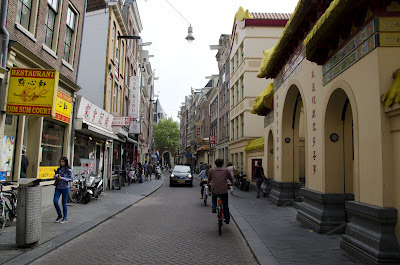 Car-lite inner ring areaThe reduced number of cars (and reduced attendant noise and stress and smells) is definitely part of what makes Amsterdam so charming and livable. I would guess there are half as many moving vehicles per square mile in Amsterdam as there are per square mile in San Francisco. All three of my kids ranked Amsterdam either 1 or 2 of the cities we visited in terms of places they could imagine living, perhaps in part because Amsterdam resembles San Francisco in both size and live-and-let-live attitude. The districts of Amsterdam I saw were more dense than San Francisco but not by much. Most buildings were four or five stories tall, retail was located under residential, there were few chain stores (though, yes, there were Starbucks), lots of shops and cafes. The apartment we rented was quite large—four bedrooms on the second floor, living room, dining room and kitchen on the first, garden in the back. (Our landlady’s unit above us occupied floors 3 and 4.) Tram one block away; grocery and other stores right around the corner. I could definitely see how you could raise a family here.
Car-lite inner ring areaThe reduced number of cars (and reduced attendant noise and stress and smells) is definitely part of what makes Amsterdam so charming and livable. I would guess there are half as many moving vehicles per square mile in Amsterdam as there are per square mile in San Francisco. All three of my kids ranked Amsterdam either 1 or 2 of the cities we visited in terms of places they could imagine living, perhaps in part because Amsterdam resembles San Francisco in both size and live-and-let-live attitude. The districts of Amsterdam I saw were more dense than San Francisco but not by much. Most buildings were four or five stories tall, retail was located under residential, there were few chain stores (though, yes, there were Starbucks), lots of shops and cafes. The apartment we rented was quite large—four bedrooms on the second floor, living room, dining room and kitchen on the first, garden in the back. (Our landlady’s unit above us occupied floors 3 and 4.) Tram one block away; grocery and other stores right around the corner. I could definitely see how you could raise a family here.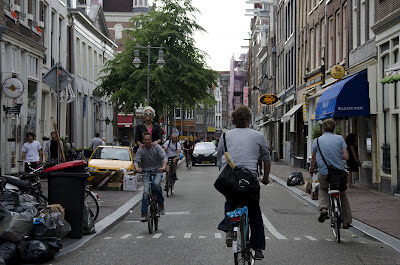 Contraflow bike lane on one-way streetAmsterdam was not high on the MAMIL index (Middle Aged Males in Lycra, a species of bicyclist my husband sometimes claims membership to.) Very little Lycra at all except for a few guys on long distance training runs. People simply rode bikes in whatever they were wearing for the day. No one wore helmets either, except a couple in Lycra. It’s a curious thing, but even though absolutely no one wears helmets, the Dutch have the lowest bicycling injury and mortality rate of any country in the West, indeed a mere fraction of our own rate. (Conclusion? Helmet use does not create bicyclist safety; good bicycle infrastructure and cars that yield create bicyclist safety.) Since there were no stop signs in Amsterdam, I never saw a bike run one, and I think I saw only one bicyclist run a red after stopping at a light. The lights, however, were very short, and we sometimes had difficulty getting all five of us across an intersection in one light cycle. Though many bike paths were asphalt, some were made of pavers laid so smoothly on sand it felt like you were riding on asphalt. Pretty great. So for those who predict peak oil means no more bike lanes, this is not necessarily the case.
Contraflow bike lane on one-way streetAmsterdam was not high on the MAMIL index (Middle Aged Males in Lycra, a species of bicyclist my husband sometimes claims membership to.) Very little Lycra at all except for a few guys on long distance training runs. People simply rode bikes in whatever they were wearing for the day. No one wore helmets either, except a couple in Lycra. It’s a curious thing, but even though absolutely no one wears helmets, the Dutch have the lowest bicycling injury and mortality rate of any country in the West, indeed a mere fraction of our own rate. (Conclusion? Helmet use does not create bicyclist safety; good bicycle infrastructure and cars that yield create bicyclist safety.) Since there were no stop signs in Amsterdam, I never saw a bike run one, and I think I saw only one bicyclist run a red after stopping at a light. The lights, however, were very short, and we sometimes had difficulty getting all five of us across an intersection in one light cycle. Though many bike paths were asphalt, some were made of pavers laid so smoothly on sand it felt like you were riding on asphalt. Pretty great. So for those who predict peak oil means no more bike lanes, this is not necessarily the case.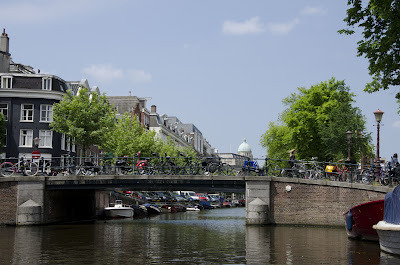 Canal bridge with forbidden bike parkingGiven the bicycle vs. auto mode share in Amsterdam (38% vs 25%) a dispro- portionate amount of space is devoted to cars and their storage. Though there is separated bicycle infrastructure on all major roads, the lanes are overly crowded because so many bicyclists are using them at all times! Because there are precious few bike racks for people to lock their bikes to, bikes are littered everywhere, even locked to canal bridge railings (supposedly a big no-no.) Since the Dutch seem fond of practicality and order, I’m mystified why they don’t take a couple car parking spots per block and create tidy bike corral parking for 30. I also don’t understand the Dutch penchant for incredibly heavy, cloth-covered chains rather than the much lighter, less awkward U-locks we use here. Our landlady in the apartment we rented (in the Oud Zuid district) was so worried about our rental bikes being stolen (even with all five locked together) that she insisted we lock our bikes to her family’s bikes that were chained to the building. The next day she coasted off on her own bike to a rehearsal at the Concertgebouw where she is a violinist. Bicyclists silently glided by our apartment (not in a touristy part of town at all) from six in the morning until well after midnight. Small children came with their parents, preteens rode alone, business people in formal wear cycled past, elderly grey-haired women with their shopping in their baskets whizzed by. Ordinary, real Amsterdamers really do bike just for basic transportation because they’ve designed their city to make bicycling fast, safe, pleasant and convenient.
Canal bridge with forbidden bike parkingGiven the bicycle vs. auto mode share in Amsterdam (38% vs 25%) a dispro- portionate amount of space is devoted to cars and their storage. Though there is separated bicycle infrastructure on all major roads, the lanes are overly crowded because so many bicyclists are using them at all times! Because there are precious few bike racks for people to lock their bikes to, bikes are littered everywhere, even locked to canal bridge railings (supposedly a big no-no.) Since the Dutch seem fond of practicality and order, I’m mystified why they don’t take a couple car parking spots per block and create tidy bike corral parking for 30. I also don’t understand the Dutch penchant for incredibly heavy, cloth-covered chains rather than the much lighter, less awkward U-locks we use here. Our landlady in the apartment we rented (in the Oud Zuid district) was so worried about our rental bikes being stolen (even with all five locked together) that she insisted we lock our bikes to her family’s bikes that were chained to the building. The next day she coasted off on her own bike to a rehearsal at the Concertgebouw where she is a violinist. Bicyclists silently glided by our apartment (not in a touristy part of town at all) from six in the morning until well after midnight. Small children came with their parents, preteens rode alone, business people in formal wear cycled past, elderly grey-haired women with their shopping in their baskets whizzed by. Ordinary, real Amsterdamers really do bike just for basic transportation because they’ve designed their city to make bicycling fast, safe, pleasant and convenient. 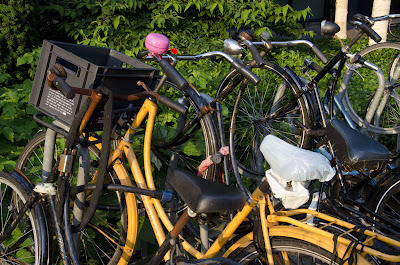 Typical Dutch bikesGarages were few and far between and pretty much no one appeared to bring their bikes inside where they live. (Perhaps they are unwilling to track dirt and muck in when it rains?) So, since Dutch bikes live outside all year around, vulnerable to both weather and thieves, the average Dutch bike looked heavy, rusted, and as if it first touched pavement in 1938. Yes, Amsterdam is flat (if you don’t count the Dutch “hills”, a.k.a. canal bridges) but they handicap themselves by riding incredibly heavy (though stately, dignified and indestructible) bikes. Though in San Francisco we have hills, we also tend to have lighter, more nimble bikes with decent gears to deal with inclines. And if you have a nice bike, you sure as heck don’t leave it out on the street at night.
Typical Dutch bikesGarages were few and far between and pretty much no one appeared to bring their bikes inside where they live. (Perhaps they are unwilling to track dirt and muck in when it rains?) So, since Dutch bikes live outside all year around, vulnerable to both weather and thieves, the average Dutch bike looked heavy, rusted, and as if it first touched pavement in 1938. Yes, Amsterdam is flat (if you don’t count the Dutch “hills”, a.k.a. canal bridges) but they handicap themselves by riding incredibly heavy (though stately, dignified and indestructible) bikes. Though in San Francisco we have hills, we also tend to have lighter, more nimble bikes with decent gears to deal with inclines. And if you have a nice bike, you sure as heck don’t leave it out on the street at night.By day three we had almost gotten biking in Amsterdam figured out, although my youngest was still nervous about crossing intersections after an incident with a tram. (Trams apparently have the right of way over everybody and do not take kindly to fourteen-year-old girls who are still in the middle of an intersection when the light turns red.) At this point we took a countryside tour to see what things looked like outside of the city. It was a different tour company with better bikes, which made me happy. We were impressed after twenty minutes of biking to be completely away from the city in open countryside. We took some great bikeways through parks, over a canal with locks, through a forest, through polders/reclaimed land, always either on pathways separate from cars or on roads with very few cars. We tasted cheese, saw an old windmill, visited a clog maker, the usual tourist stuff. We learned that when it comes to hydrological engineering, the Dutch are masters (a skill they will need in a big way with rising sea levels.) A very enjoyable afternoon.
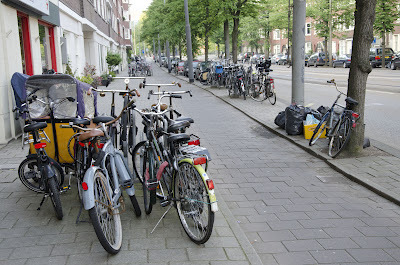 Not much space for pedestrians (bike path in middle)So we come to the walking experience in this land of bicycles. Though we biked a lot, we also walked miles and miles in Amsterdam. It is a lovely place to wander around. There are some pedestrian esplanade/ plazas connecting residential areas that are idyllic, and the whole inner ring area is great fun for people watching/ window shopping/strolling. However, although sometimes Amsterdam’s bicycle lanes and bike parking seems to come from space previously given to cars, other times it appears carved from pedestrian ways, leaving pedestrians too little space. In addition, the first two days when walking in Amsterdam, even though I was warned, we nearly got run over by bicycles. By the third day we learned to always, always (!) look for bikes before crossing a bike path or just stepping anywhere at any time. Just as in San Francisco we would never step into the street without glancing for cars, so for the Dutch looking for bicycles is instinctive. As far as I could tell, bicyclists do not yield to pedestrians in Amsterdam. The Dutch see nothing wrong with this, probably because they are all bicyclists more than pedestrians themselves. In fact, when I stopped for pedestrians in cases where they seemed to clearly have the right of way (i.e. a crosswalk), the pedestrians looked at me with bemused confusion and waited for me to pass. After a time or two of this, I shrugged my shoulders, said “when in Rome,” and proceeded to ignore pedestrians thereafter.
Not much space for pedestrians (bike path in middle)So we come to the walking experience in this land of bicycles. Though we biked a lot, we also walked miles and miles in Amsterdam. It is a lovely place to wander around. There are some pedestrian esplanade/ plazas connecting residential areas that are idyllic, and the whole inner ring area is great fun for people watching/ window shopping/strolling. However, although sometimes Amsterdam’s bicycle lanes and bike parking seems to come from space previously given to cars, other times it appears carved from pedestrian ways, leaving pedestrians too little space. In addition, the first two days when walking in Amsterdam, even though I was warned, we nearly got run over by bicycles. By the third day we learned to always, always (!) look for bikes before crossing a bike path or just stepping anywhere at any time. Just as in San Francisco we would never step into the street without glancing for cars, so for the Dutch looking for bicycles is instinctive. As far as I could tell, bicyclists do not yield to pedestrians in Amsterdam. The Dutch see nothing wrong with this, probably because they are all bicyclists more than pedestrians themselves. In fact, when I stopped for pedestrians in cases where they seemed to clearly have the right of way (i.e. a crosswalk), the pedestrians looked at me with bemused confusion and waited for me to pass. After a time or two of this, I shrugged my shoulders, said “when in Rome,” and proceeded to ignore pedestrians thereafter.We opted to mostly walk and bike rather than take public transport in Amsterdam, though when we did take the tram I was amazed at how insanely quiet it was, both inside and out (especially when compared to San Francisco’s noisy behemoths.) Truly, it made me wonder what the heck is wrong with us that our light rail is so clunky and loud. The trams were a bit on the pricey side--a one-hour ticket was 2.7 Euros (about $3.30)—but residents can buy a monthly ticket for 81 euros, which is more in line with SF Muni prices. However, the trams were not ever packed as far as I could tell. There is also an underground metro in Amsterdam but it didn’t seem to serve the city center much and we didn’t use it. The bicycle really seemed to be the way to get around. If I were to do our trip all over again, I would rent better bikes and spring real money to get a decent map, but I would definitely bike again in Amsterdam despite the hair-raising nature of the first days.
Just as a note, two themes we heard a lot about in Amsterdam were 1) total national distress that the Dutch football (i.e. soccer) team had gotten tossed out early in the Euro Cup rounds, and 2) that everyone was thrilled to see the sun that week since they hadn’t seen it in a while. (They basically implied that it rained there constantly, worse than Seattle. Indeed, their annual precipitation levels are comparable.) In addition, World War II still casts its shadow here, and not only at the Anne Frank House. Right outside our apartment was a haunting statue of three men, representing the twenty-nine neighborhood men executed by Nazi occupiers right at that spot in retaliation after a Nazi officer stationed across the street was killed by resistance fighters.
I was impressed at how athletic the Dutch are. There is a range of body types, some slim, some heavier, but everyone was fit, no one obese, everyone more than up to a sprightly walk or bike ride. In fact, the Dutch think there’s no better way to spend a weekend than getting some exercise and fresh air out in the country. And they long for cold snaps to freeze over the canals (which doesn’t happen often) because then they get to skate! This attitude towards fitness and incorporating exercise into their everyday lives may be why the Dutch spend 60% as much on health care as the US does (counting both public + private expenditures), have an adult obesity rate of only 12% (compared to ours of 34%), and also have a longer life expectancy to boot. (It can’t be their alcohol or cigarette consumption—they smoke and drink more than we do. However they do drink less than half the soda pop that we consume.)
As we took an early train out of Amsterdam the last morning, we passed through suburbs and then villages and small towns spaced farther apart. On every road I could see there were substantially more bikes than cars zipping happily along in the morning sunshine.
Next stop: Evolving, Fascinating Berlin.
Note: While it’s far preferable to reduce one’s carbon emissions rather than purchase offsets for them, for this trip we did buy carbon offsets for our airplane flights through Terrapass, a company that does a good job of funding carbon/methane reduction projects that would not happen otherwise.
Published on August 13, 2012 13:37
July 17, 2012
The Different Kinds of Hope
 There is more than one kind of hope.
There is more than one kind of hope.First off, there is the no-hope kind of hope, believing nothing can change a situation. The plug has been pulled, and all that's left is to watch the water swirl down the drain. And indeed there are times when events are so large and already in play that there's little one can do. If a tsunami threatens, you run as far and as high as you can, but you aren’t going to move your house or stop the water. It’s too late for that. On a drier day, if your house catches fire, you can try to put it out, but at a certain point it’s best just to get out and watch it burn. Stay alive to rebuild another day. If you have a terminal illness you can undergo various costly procedures that have little chance of working, or, with as much equanimity as you can muster, you can focus on the quality of life of the time you have left. So there are situations when no hope (the acceptance phase in Kubler-Ross’s five stages of grief) is the right choice. Some might call it pessimism, some might call it realism. It can be seen as giving in to despair or just sheer logic and pragmatism. Sometimes, though, "no hope" is used as an excuse when something actually could've been done to remedy a situation. Sometimes "there's no hope" is short-hand for "I just don't want to inconvenience myself in any way."
Then there is passive hope. The belief that, in spite of everything, things will work out for the best. That somehow, without effort on our part, our problems will be solved. And indeed, sometimes the universe does seem to work in mysterious ways. One of my favorite themes running through Shakespeare in Love:
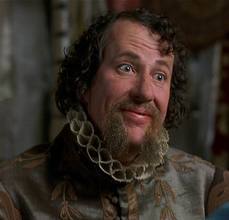 Hugh Fennyman
: So what do we do?
Hugh Fennyman
: So what do we do? Philip Henslowe : Nothing. Strangely enough, it all turns out well.
Hugh Fennyman : How?
Philip Henslowe : I don't know. It's a mystery.
A caricature of passivity, Henslowe goes with the flow even though it makes him anxious and he nearly gets his ear cut off. And, lo and behold, his philosophy proves sound! Things work out with very little intervention on his part. Happy endings abound, or at least the show goes on.
The last kind of hope is active hope. It requires action in the face of uncertainty. We hope that our children will grow up happy and healthy. We can’t guarantee it, but we take as much action towards that goal as we can, and then optimistically hope for the best.
The universe appears to like those crazy optimists. Studies show that while pessimists have a much more accurate view of circumstances, optimists have better outcomes in life. This is because by believing a situation is rosier then it actually is, optimists try. They don’t give up, they don’t admit defeat before they’ve even begun. So because they try, they succeed more often than pessimists whose more realistic understanding of a situation leads them not to try at all.
But these studies only hold true for active optimists, not passive ones.
Consider this scenario: you have a patch of ground in your yard and you would like it to produce fresh vegetables for you. A pessimist might say that there isn't enough sun, the soil is too compacted, the probability of pests too great to make a garden worth the effort. An active optimist would loosen the soil, add the compost and fertilizer, trim back some overhead branches to let in more light, plant the seeds, and see what happens. Maybe the pessimist is right, maybe the garden will not produce, but the active optimist is willing to put in the effort and take his or her chances. A passive optimist would wish a garden to just show up in the patch of ground. Who knows—a bird could drop seeds from overhead, a neighbor could just up and plant some stuff, perhaps seeds might fall from a plane. Maybe a random person passing by will feel the urge to sow something in the dirt. It could happen.
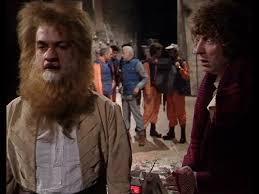 Passive hope has its literary and cultural precedents. In The Three Musketeers,Athos decides there’s no way he can come up with the money to equip himself for the next battle campaign so decides he might as well sit in his room and wait for the equipment to come to him. And, remarkably, it does, thanks to his active, generous (and it turns out, lucky) friend, d’Artagnan. And in one of my favorite Dr. Who episodes, Warrior’s Gate, as the characters search frantically for a way to avoid imminent collapse into a singularity, one of the characters advises the Doctor to do nothing. (This is largely because that character has taken matters in hand in a way the Doctor does not yet understand.) As disaster approaches the Doctor finally recognizes that sometimes doing nothing is appropriate, “if it’s the right sort of nothing.”
Passive hope has its literary and cultural precedents. In The Three Musketeers,Athos decides there’s no way he can come up with the money to equip himself for the next battle campaign so decides he might as well sit in his room and wait for the equipment to come to him. And, remarkably, it does, thanks to his active, generous (and it turns out, lucky) friend, d’Artagnan. And in one of my favorite Dr. Who episodes, Warrior’s Gate, as the characters search frantically for a way to avoid imminent collapse into a singularity, one of the characters advises the Doctor to do nothing. (This is largely because that character has taken matters in hand in a way the Doctor does not yet understand.) As disaster approaches the Doctor finally recognizes that sometimes doing nothing is appropriate, “if it’s the right sort of nothing.”There is indeed a time and a place for the Zen minimalism of doing the right sort of nothing. Most of the time, however, the Doctor and Athos are lively shapers of their fate. In fact, they only refrain from action the rare times when it is wiser to let other characters do the work. Though in Shakespeare in Love it’s a mystery to Henslowe how the play inevitably does go on, we see that the other characters struggle mightily to write a great play, cast it, rehearse it, scheme, organize, deal with reversals, push and strive to make the play a success.
As Kipling observed,
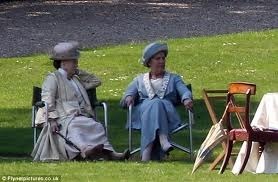 "Gardens are not made by singing ‘oh how beautiful’ and sitting in the shade.“
"Gardens are not made by singing ‘oh how beautiful’ and sitting in the shade.“ Most of the time someone must prepare the soil, plant some seeds and tend them with a certain amount of care. Most of the time if a community doesn’t manage its sewage and sanitation effectively, it is prone to outbreaks of disease. Most of the time if you use your chimney year after year without cleaning it, it will fill with soot and catch on fire. Some things one can trust to God or the universe to take care of, but other things are such a basic matter of cause and effect that God and the universe expect us human beings to stop being stupid and lazy and take care of them ourselves.
 So where is this essay leading? In the last 150 years, with the advent of the unprecedented energy provided by fossil fuels, human population has exploded. We’ve made clever use of this energy to feed unprecedented numbers of people and raise standards of living for some to the levels of kings and queens of yore. In doing so we’ve spewed enough carbon, methane and other gases in the atmosphere that we are on track to transform our planet into a scorching hell. Why we lack urgency about this matter is because when it comes to carbon emissions, there is a time lag between cause and effect. This summer we are feeling the effects of carbon emitted fifty years ago. Unless we quickly get into the business of absorbing carbon rather than emitting it, the carbon we spew into our atmosphere this summer will be felt by our progeny fifty years hence.
So where is this essay leading? In the last 150 years, with the advent of the unprecedented energy provided by fossil fuels, human population has exploded. We’ve made clever use of this energy to feed unprecedented numbers of people and raise standards of living for some to the levels of kings and queens of yore. In doing so we’ve spewed enough carbon, methane and other gases in the atmosphere that we are on track to transform our planet into a scorching hell. Why we lack urgency about this matter is because when it comes to carbon emissions, there is a time lag between cause and effect. This summer we are feeling the effects of carbon emitted fifty years ago. Unless we quickly get into the business of absorbing carbon rather than emitting it, the carbon we spew into our atmosphere this summer will be felt by our progeny fifty years hence. 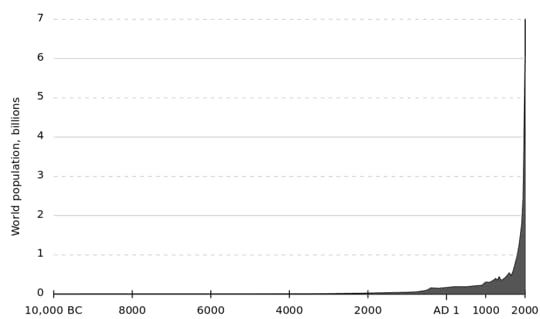 Human Population
Human PopulationIf we don't put the brakes on our collective carbon emissions, the earth’s temperature will rise 7 degrees F (4 degrees C) within our children’s lifetimes. This will be the hottest the earth has been in 30 million years. Half of all species presently living will go extinct, arable land will dwindle drastically, starvation and/or flooding will create hundreds of millions of refugees, and hundreds of millions will die from disease and/or starvation. This rise in temperature of 7 degrees F will likely trigger further feedback loops that will raise temperatures even further: to an 11 degree F rise within our grandchildren’s lifetimes, and to a 22 degree F rise by the year 2300. Ultimately, this will mean billions of humans dying with the earth so hot, survivors will be driven to live underground or in scattered, isolated areas still cool enough for human existence. If this is not a human extinction event, then it will be very close to it.
The future we are now creating for our children and grandchildren is bleak. Rapid climate change will bring about devastation and destruction on a scale worse than any war, any drought, or any plague humans have ever endured. The suffering and loss of life will be far worse than anything Hitler or Stalin ever dreamed of. Climate change on this scale is not just a possibility. If temperatures rise high enough to melt the methane frozen in the ocean and the arctic permafrost, it is a certainty. And methane has already begun to bubble up from the Arctic Ocean in plumes never before seen.
We can do nothing, of course, and hope for the best. Maybe an ice age will shortly set in and the earth will cool by itself. Maybe kindly aliens will arrive from outer space and save us. Maybe someone, somewhere will come up with some technology that will fix everything just fine. Surely if things were really bad our politicians would act responsibly and lead us down a sensible path. Why inconvenience ourselves, why spend money on energy sources that don’t destabilize the atmosphere, why change our lifestyles to reduce the amount of energy we consume, why go to the trouble of figuring out how to live in balance with our planet when there is a tiny chance some other force will step in and do the work for us?
 This is passive hope, often known as wishful thinking. We are Sleeping Beauty dreaming that someday our prince will come and solve all our problems. No need to fight dragons or witches. No unpleasantness, no effort, no responsibility. Just deep, deep unconsciousness.On the other hand, if we have no hope, if we believe humans are too selfish, greedy and short-sighted to change, that extinction is our species’ fate, then we will do nothing as well. Indeed, I wrote a blog post about the futility of spitting in the wind. In Beaufort 1849, Jasper attempts to persuade antebellum Beaufort to avoid its terrible fate. Finally he recognizes that regardless of what he might say or do the townsfolk are dead set on hurtling themselves towards secession and oblivion. He goes from active hope to no hope, although by letting go of his hope for the South, he is able to have hope for himself. But the Civil War, although a terrible tragedy that caused a great deal of death and suffering, didn’t mean the end of life on Earth for most people or whole species. The devastation was localized, reversible, and the people who suffered largely (though certainly not entirely) held at least some responsibility for the problem. (There are arguments to be made that before the war the North profited almost as much as the South from Southern slavery; it was only because the South wanted to extend its economic system into the West that the North put its foot down.)
This is passive hope, often known as wishful thinking. We are Sleeping Beauty dreaming that someday our prince will come and solve all our problems. No need to fight dragons or witches. No unpleasantness, no effort, no responsibility. Just deep, deep unconsciousness.On the other hand, if we have no hope, if we believe humans are too selfish, greedy and short-sighted to change, that extinction is our species’ fate, then we will do nothing as well. Indeed, I wrote a blog post about the futility of spitting in the wind. In Beaufort 1849, Jasper attempts to persuade antebellum Beaufort to avoid its terrible fate. Finally he recognizes that regardless of what he might say or do the townsfolk are dead set on hurtling themselves towards secession and oblivion. He goes from active hope to no hope, although by letting go of his hope for the South, he is able to have hope for himself. But the Civil War, although a terrible tragedy that caused a great deal of death and suffering, didn’t mean the end of life on Earth for most people or whole species. The devastation was localized, reversible, and the people who suffered largely (though certainly not entirely) held at least some responsibility for the problem. (There are arguments to be made that before the war the North profited almost as much as the South from Southern slavery; it was only because the South wanted to extend its economic system into the West that the North put its foot down.)This is not the case now. The earth may indeed heal itself after all this, but it will take millions of years. The people who will suffer the most are ones not yet born, and the plant and animal species that will die off will hardly be responsible for their extinction. In addition, while Jasper could leave the South, as far as I know we can’t leave our planet. We have nowhere to go. Even if the odds of fixing our predicament are low, to not even try, to give up while there is still a chance of avoiding catastrophe is senseless and immoral. We have a responsibility to step up to the plate and do our best to prevent suffering rather than inflict it. To save who and what we can. This is active hope.
We have a chance now, a chance that grows slimmer each year. Time is slipping through our fingers.
If it’s hard to understand how our continued emissions of methane, CO2 and other gases has endangered the stability of our climate, watch this TEDx talk, Climate Change is Simple, below. This is not fear-mongering, Chicken-Little-the-sky-is-falling. This is Jasper telling antebellum Beaufort their entire way of life is going to end if they continue on the path they’re on.
No hope, passive hope, active hope. The first two take no effort but are unlikely to end in anything but tragedy. The third takes effort, investment, and a willingness to change, with no guarantees that the effort won't be for naught. Which one will we choose?
(A future post will cover how to reduce one’s carbon footprint by ten percent a year for the next five years, both the money-is-no-object way and the keep-within-a-reasonable-budget way.)
Climate Change is Simple:
Published on July 17, 2012 17:13
June 12, 2012
Why Aren't More Engineers Graduating From Our Colleges?
 The missing engineer? There has been handwringing in the media lately about why our colleges and universities are not producing more STEM (Science, Technology, Engineering and Math) majors as well as about the dearth of female engineers in Silicon Valley. Having an engineering degree myself, a husband with an engineering degree, a son who has just completed an engineering degree, a daughter who is considering an engineering degree, a sister who is an engineer, a brother-in-law who is an engineer, friends who teach engineering, and being an advisor to a young woman who is interested in medical school but is not afraid of math or science, the difficulty of attracting and retaining STEM majors has been nagging at me.
The missing engineer? There has been handwringing in the media lately about why our colleges and universities are not producing more STEM (Science, Technology, Engineering and Math) majors as well as about the dearth of female engineers in Silicon Valley. Having an engineering degree myself, a husband with an engineering degree, a son who has just completed an engineering degree, a daughter who is considering an engineering degree, a sister who is an engineer, a brother-in-law who is an engineer, friends who teach engineering, and being an advisor to a young woman who is interested in medical school but is not afraid of math or science, the difficulty of attracting and retaining STEM majors has been nagging at me.First off, not all STEM majors are equally in demand on the job front. Over the years I’ve known many brilliant physicists unable to find a job in their field, and biology majors (the major of choice for pre-meds) currently appear to be in oversupply. What is in demand right now are grads with degrees in computer science, mechanical engineering and electrical engineering. Other forms of engineering also reliably lead to jobs, and math majors report hiring success although their job title is unlikely to be “mathematician.”
So why don’t more American kids go into engineering if that’s where the jobs are? In my observation, there are a number of reasons:1.) Follow the money. Engineering is considered less prestigious than medicine, law, and business, and less likely to lead to a high income, regardless of current starting salaries for engineers. Like it or not, medicine especially has more cachet with top students and their parents which mean talent flows endlessly in that direction. 2.) Engineering is hard. It’s not just that the material is conceptually difficult. There are many kids who could make it through engineering curriculum that get shunted away because:a.) Engineering schools are notorious for much harsher grading than humanities and sciences. (Average grades range from ½ to almost a full letter grade lower.)b.) Engineering schools are notorious for their incredibly heavy workloads. Getting a degree in engineering means cramming 5 – 6 years of normal college workload into 4. The result is the average engineer has less free time and less fun than the average humanities major. Engineers will tell you their classes are twice as hard as humanities classes for half the units. In fact, most upper-class engineers regale prospective frosh engineers with horrific stories about their workload and how easy "fuzzies" (non-techies) have it, their tales punctuated by bitter laughter.c.) Engineering schools require tortuous engineering breadth courses, mostly because whoever designed the curriculum took them so you should, too. But it's pointless. The amount of knowledge I retained a month after my circuits, material science or aero-astro engineering classes I could’ve picked up from a few hours of watching Discovery Channel. (Oh, the needless suffering. My statics class, on the other hand, was actually interesting, potentially useful, and not too bad.)d.) Because of the heavy course load, engineers have to start taking the engineering core courses freshman year and dive heavily into their major sophomore year. While one can decide to major in English or political science spring of sophomore year without problem, beginning engineering spring of sophomore year would make graduating on time nearly impossible. Leisurely dabbling and taking time to make up one’s mind is not a luxury engineers have.3.) Engineering schools at state universities often severely limit the available slots making it both very hard to get in and very hard to switch majors if a kid later decides another form of engineering would suit him/her better. (In California, for example, many, many qualified kids are turned away from the engineering schools at the UC’s and the Cal Poly’s.) 4.) High GPAs are extremely important in law and medical school admissions. In addition law and medical school admissions committees seem to place little value on engineering and the analytical thought process it develops. This results in law and medical schools refusing to cut engineers much GPA slack in their admissions processes. So anyone thinking they might, in the entire course of their life, ever apply to law or medical school takes an enormous risk to major in a field that produces notoriously low GPAs. At Stanford, for example, fully 1/3 of freshmen enter as pre-med (an extraordinary number.) Less than half of these eventually apply to med school. Very few of these pre-meds major in engineering even though the majority could probably do the work, and there is a bioengineering major designed pretty much just for them. Many of those initial pre-meds who later decide med school is not for them might have been very happy with engineering had they not been frightened away from it as frosh pre-meds.5.) Math departments have an innate disdain for engineers (practical, grimy brutes uninterested in the beauty of proofs) and don’t go out of their way to teach math in a manner that is helpful for budding engineers. In my day, the rumor was that the math faculty drew straws to see who got stuck teaching freshman calculus. In any event it was usually the lowest status, most heavily-accented adjunct (if not visiting) professor who taught calculus to engineers, not always a recipe for success.6.) The number of units required for an engineering degree makes it very difficult (though not absolutely impossible) to double major or study overseas. It also leaves much less room in the schedule for just sheer academic fun and exploration, supposedly part of what college is all about.
All these factors mean that unless a kid is willing to work very hard and knows with certainty at age 18 that he/she wants to be an engineer and nothing else, he/she is likely to shy away from engineering and never know if it might be interesting, less hard than they thought, lead to interesting work, etc.
This is not to say that the humanities have no value! I was an English major undergrad—I love literature and history! I certainly understand that not everyone is cut out for engineering and that the world would be a dull place indeed if it were only made up of engineers (or only pre-meds, or only art history majors, or only economists . . . ) But it seems counterproductive to make engineering quite so miserable, quite so risky (for anybody needing a high GPA for grad school) and require quite so many sacrifices on the part of the average 18 year old.
In addition, if engineers are in demand and important to a state’s economy, why doesn’t that state’s universities accept more kids into their engineering programs? It may cost more, yes, but to skimp on engineers when kids want to study the subject and employers need the grads for their companies to thrive seems insane or at least economically demented.
Perhaps engineering should be a 5 year program rather than cram so much into just 4 years. Perhaps some of the more nonsensical breadth requirements could be reduced. Perhaps law and medical schools could be convinced to give engineering GPAs a substantial bump when considering them against bio or history majors. It just seems to me that a lot of smart, talented kids who could be quite successful as engineers are kept away from the field needlessly.
Published on June 12, 2012 22:51
May 30, 2012
What If
Questions on my mind lately—

What if the measure of our life is not wealth, status, or prestige but our moments of connection—with others, with nature, with the universe?
What if happiness cannot be achieved in and of itself but occurs as a by-product of health, connections and deep alignment with our true nature?
What if the greater our rate of consumption—of goods, energy, even experiences—the more dissatisfied we become?
What if no one can give us health, but instead we create it through diet, habits, and thoughts? (Plus access to clean water and effective communal sanitation.)
What if the more media we imbibe the less clearly we think?
What if the faster we go, the less we achieve? Is there a point of stillness around which our life turns?
What if good karma is created by kindness and bad karma by its absence?
What if the state of the world reflects the state of our consciousness, our soul?
(photo credit: Peter Stamats)
Published on May 30, 2012 10:27
April 15, 2012
To the Seniors of 2012
As T. S. Eliot might have said, it’s that time again—April, the cruelest month for high school seniors, breeding college admissions out of dormant applications, mixing longing and aspiration, stirring anxiety with judgments from on high. A first love with a perfect quadrangle rejects, an inviting suitor plays coy with a waitlist, and an underrated wallflower beckons “choose me, choose me!” Hearts are broken, dreams rent into pieces. The Paths That Will Not Be Taken calcify into stone for all time.
It all seems to matter so terribly much.
And yet it doesn’t matter, not really, or at least far less than you might think.
What does matter, dear senior—oh so critically—is your attitude. What matters is whatever you do next year, and wherever you do it, you develop (or reinforce) a lifelong habit of learning and growth. Perhaps you realize a bad attitude can render even Harvard a useless experience. What you may not be so sure of is that a good one can transform even a transitional year at community college into a work of living art.
Life is strange. It surprises, weaves and darts. It throws us curve balls, pushes us in directions we are sure we don’t want to go. It disappoints us, crushes us, picks us up by our heels and shakes us mercilessly until we cry uncle. Until we are ready to open our eyes and see that what it’s offering us might be exactly what we need for our growth, albeit in ever so strange a way.
Some of you may not like what life is offering you right now. Some of you may downright resent it. You’ve worked hard, you say (and you have!); you deserve more. Many of you may have financial constraints that harshly limit your choices. It’s easy to be bitter about a supposedly meritocratic system that gives advantage to those with more money. It’s easy to be angry at an institution that says, with little camouflage, “You’re not good enough for us.” Most damaging of all, perhaps, is when the decisions do go your way, when elation whispers like a cunning Iago, “You are now one of the select. Your future will unfurl before you in swirls of effortless glory.” All of these responses are traps.
Let’s be clear: The college you attend does not define your worth as a human being. (Nor do a few three and four digit numbers sum up your ability, your potential, or even say much about the inner workings of your mind.) Truly. Even if there weren’t wild amounts of randomness and luck involved in college admissions, even if your parents’ income and background didn’t matter, even if a test existed that could somehow measure the depth of your soul, the loving nature of your heart, the soaring possibilities of your spirit, there would still be no way in twenty minutes (the time admissions personnel may spend on your application if you’re lucky) that your value to the world could be evaluated. Not possible. Toss the very notion from your head.
Nor does the college you attend predict what you can do or achieve in life. You can learn new skills, find talented teachers, and encounter kindred spirits anywhere (although these teachers and kindred spirits may look different than you expect and hence be hard to recognize.) In addition, in the US, with the right effort and attitude, almost any college can be a springboard to another. Take advantage of this if it makes sense for you (but never out of bitterness or scorn.)
College is not a reward for hard work, nor is it a perfunctory ticket to be punched on the way to a job. College is an opportunity, one that you may put to good use or squander. It is also an investment. This country collectively pours enormous resources into its tertiary education system not because we want to create a playground for you to twiddle away your next four years, but because what you can learn, do, and become during your time at college—both in the classroom and outside of it—is vital to our long-term welfare as a nation. (A note: even though education is valuable, be judicious about the loans you take on. Debt has consequences.)
What is important about the next four years is not which school you go to, how famous your professors are, what books you read, or what facts you memorize. It is not your major, your degree, how much money you will earn after you graduate, which renowned diploma will or will not imbue your life with its ineffable prestige. What is important is your growth and exploration as you become the person you are meant to be.
I don’t know if you’ve noticed, but there are large (very large) (even formidable) problems looming ahead. Many, I’m sad to say, were created by my generation and the one before it—or at least these problems weren’t addressed and were allowed to snowball into enormous size. Through no fault of your own, the bills are coming due, someone has turned off the party music, bad smells waft from the bathroom, and the lights are flickering ominously. I am deeply sorry about this. However, since my generation is fast fading from usefulness, yours will inevitably be the one obliged to grapple with the aftermath as best you can. Much will be called for, including your focus, your passion, your commitment. The world will need your energy, your tenacity, your ingenuity; it will demand your compassion, your courage, your strength. And you will need all sorts of skills and knowledge, some that may not even have been invented or discovered yet.
Luckily skills and knowledge can be gained many places from many sources. In fact, life may surprise you with just who your best teachers turn out to be. Because the world is wide, varied, and rapidly changing, your years at college will at best only give you a sample of the larger whole. There can be no resting on laurels. Having lived half a century, I can say three-fourths of what I know I learned after I left academia behind. The good news is that learning keeps you energetic and interested in life. The good news is that huge problems offer huge opportunities. It is possible the challenges ahead will draw from you and your cohorts creativity and camaraderie that will be absolutely exhilarating.
We are all interconnected. All of us who have come before you need you to hold up your share of the sky. For all our faults and failures, we have also held up our share and know both the joy and the burden that await you. I don’t profess to know what your life’s purpose is—it’s a seed inside you that you must feed and nurture and then see what blossom results. Who knows? You might turn out to engineer low-cost water purification systems for African villages. You may design urban parks that create oases of serenity as well as provide a third of a neighborhood’s food supply. You might be a teacher who can convey the beauty and usefulness of math, or a social worker who helps broken people heal enough to beat their drug addiction. You may do a stint as an endlessly patient and loving stay-at-home mom or dad. You may end up a politician more concerned with the well-being of your constituency than your campaign contributions who guides your community through useful and intelligent change. You may even be a sci-fi short story writer who is also a heck of a shoe repairer so that you both stimulate the collective imagination and ensure your community stays fit and mobile in well-maintained footwear.
Whatever path you choose, as long as your integrity, commitment and energy are high, the outcome will be valuable and significant. Yes, in the large scheme of things, the college you go to is of little consequence. But you, dear senior, are very important. Though it may seem incomprehensible right now, what you do with your education and your life matters to each and every person on this planet. Your very existence gives hope to those of us who’ve come before you. We await your contribution. Don’t waste a moment. Go forth, seniors of 2012, and shine.
Published on April 15, 2012 17:44
March 7, 2012
Useful Skills for a Gift Economy
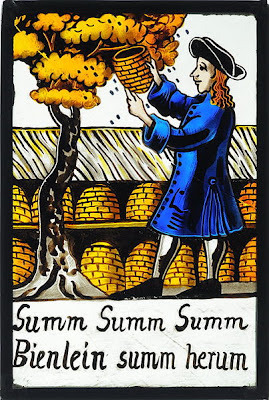 Long Ago BeekeepingDon't quit your day job, but what second set of skills mightyou have that would be useful in a gift economy? Are there goods you make or aservice you could render as a present or for informal trade? For a skill to bevaluable, there must be some barrier to entry. Usually this barrier (whyeveryone just doesn't do it themselves) is a certain amount of specializedknowledge or equipment. Sometimesit is talent!
Long Ago BeekeepingDon't quit your day job, but what second set of skills mightyou have that would be useful in a gift economy? Are there goods you make or aservice you could render as a present or for informal trade? For a skill to bevaluable, there must be some barrier to entry. Usually this barrier (whyeveryone just doesn't do it themselves) is a certain amount of specializedknowledge or equipment. Sometimesit is talent! My husband and I have taken up beekeeping. It'snot all that hard but it does take some know-how and special apparatus. I'vealso put in a vegetable garden and fruit trees in our urban yard. While lettuceand zucchini seem so easy to grow anyone could do it, tomatoes and pumpkinstake more of a green thumb. Fruit trees take years to mature so they definitelyrepresent an investment. I've thought long and hard about raising chickens butam unwilling to do the work required. (Effort--a significant barrier to entry!)
Below are some of the skills sets I've been thinking aboutlately. Not that I have any desireto acquire them all myself, but having friends and relatives with a widevariety of them would definitely be a good thing! Many of the skills are verytraditional but some are more modern. An amateur might not perform them as well as a professional butcould still achieve enough proficiency to be valued.
If you have any of these skills, how did you acquirethem—from a friend or relative, a class, from a book oron-line? In the past parents or grandparents handed down these skills, but this has been less common the last fewgenerations. For beekeeping I wentto class, read a couple books and read a lot on line. For vegetable gardening Iread books, read on-line, and went back to memories of previous gardens I'vehad and my father's gardening as I grew up.
Are there any skills you'd add to this list?
*Canning/food preservation*Soap making*Beer brewing*Winemaking*Cheese-making*Chicken-raising (eggs)*Beekeeping (honey)*Simple bicycle repair*Fancy cakes (parties/wedding)*Hand sewing/clothes mending*Machine sewing/clothes making*Knitting (socks and sweaters in particular)*Crocheting*Quilting*Woodworking/furniture making*Fruit/nut tree growing*Child party host (art/games/fun themes?)*Handyman carpentry repair*Simple insulation/weatherstripping/house sealing*Vegetable garden tending*Herbs (wildcrafted or domestic)*Tree pruning*Simple electrical wiring*House painting/decorative finishes*Candle-making*Cooking (specialized, time intensive, or gourmet food)*Baking (bread, pies, etc.)*Simple haircuts/hair styling/hair dying*Manicuring*Shoe repair*Computer geek*Website development*Meat or fish smoking*Liqueur making*Tutoring (math, science, writing, foreign language, testprep)*Jewelry making/repair*Doll/toymaking*Play a musical instrument (well enough for a wedding,party, etc.)
Photo (of old German stained glass): Ingeborg Bernhard
Published on March 07, 2012 17:05
February 10, 2012
Echoes of the Twelfth Century in Golden Gate Park
 The magnolias were in bloom yesterday at the Botanical Garden in San Francisco. The sky was cornflower blue; the sun's rays were warm and golden. Spring usually arrives the first week of February in this city, a fact for which I am grateful, especially if January has been cold and wet. So I took a bike ride to Golden Gate Park where the unfurling pink and white velvet of magnolia petals were a delicious treat.
The magnolias were in bloom yesterday at the Botanical Garden in San Francisco. The sky was cornflower blue; the sun's rays were warm and golden. Spring usually arrives the first week of February in this city, a fact for which I am grateful, especially if January has been cold and wet. So I took a bike ride to Golden Gate Park where the unfurling pink and white velvet of magnolia petals were a delicious treat. 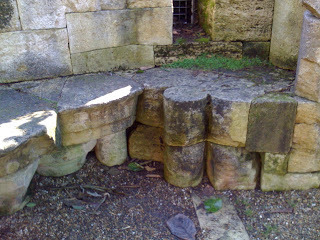 Do they chant Gregorian?As I strolled through the arboretum, in the midst of the Rhododendron Garden I ran across a circular seating area made out of stones that struck me as old. Very old. And the stones had personality. Soul, even. As I examined them, I noticed the stones were cut and carved in shapes that reminded me of, well, a medieval church of all things. Odd. What were medieval-looking stones doing in the arboretum of a city not exactly known for medievally-inspired architecture?
Do they chant Gregorian?As I strolled through the arboretum, in the midst of the Rhododendron Garden I ran across a circular seating area made out of stones that struck me as old. Very old. And the stones had personality. Soul, even. As I examined them, I noticed the stones were cut and carved in shapes that reminded me of, well, a medieval church of all things. Odd. What were medieval-looking stones doing in the arboretum of a city not exactly known for medievally-inspired architecture? Time for some research! It turns out these stones are not medieval-looking, they are the real thing, remnants of a twelfth-century Cistercian Spanish monastery. I kid you not. They are likely the oldest things you can touch in the city limits of San Francisco. How they ended up halfway across the world surrounded by rhododendrons is your usual story of power, greed, bureaucratic incompetence, and Byzantine San Francisco politics, combined with a dab of grace and a sprinkle of serendipity.
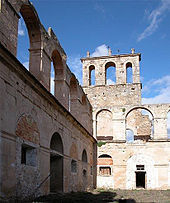 What's left of the monasteryConstruction began on the Cistercian monastery of Santa Maria de Ovila (in the Spanish province of Guadalajara) in 1188, probably to help hold the border area that King Alfonso VIII had recently reconquered from the Moors. A small monastic community thrived there over the centuries but eventually faded to the point that in 1835, by royal decree, the monastery was secularized and fell into private hands. Over time the site decayed, any portable parts of value were sold, and its buildings were used as barns and even a manure pit. Volunteer shrubbery grew from the vaulting. One can imagine goats traipsing through the abandoned interior.
What's left of the monasteryConstruction began on the Cistercian monastery of Santa Maria de Ovila (in the Spanish province of Guadalajara) in 1188, probably to help hold the border area that King Alfonso VIII had recently reconquered from the Moors. A small monastic community thrived there over the centuries but eventually faded to the point that in 1835, by royal decree, the monastery was secularized and fell into private hands. Over time the site decayed, any portable parts of value were sold, and its buildings were used as barns and even a manure pit. Volunteer shrubbery grew from the vaulting. One can imagine goats traipsing through the abandoned interior. 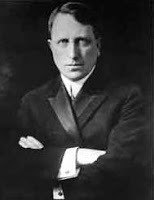 Our story now advances to another century and another continent where the brashest of characters arrives on the scene—William Randolph Hearst, media tycoon extraordinaire. He has just had so much fun building Hearst Castle in San Simeon that he has another project in mind, a true blue medieval castle to replace his mother's burnt down summerhouse near Mount Shasta. Medieval castles scarce in California? If you're William Randolph Hearst, this is not a problem. Just get one from Spain!
Our story now advances to another century and another continent where the brashest of characters arrives on the scene—William Randolph Hearst, media tycoon extraordinaire. He has just had so much fun building Hearst Castle in San Simeon that he has another project in mind, a true blue medieval castle to replace his mother's burnt down summerhouse near Mount Shasta. Medieval castles scarce in California? If you're William Randolph Hearst, this is not a problem. Just get one from Spain! 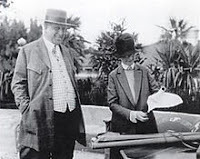 Hearst and Morgan, medieval on their mindsGood old Hearst, looting the treasures of Europe right and left like they were bonbons for the taking. His agent in Spain recognized Hearst's potential castle walls in the decrepit Santa Maria de Ovila monastery. He quickly arranged to buy the structure from the owner who, it fortuitously turned out, could use the extra $97,000 in cash. Julia Morgan, Hearst's trusted architect who had designed his "castle" in San Simeon, drew up the plans for the proposed Wyntoon Castle based on the components Hearst had purchased. The monastery's Chapter House would become the castle's entrance hallway; the Refectory would be the "armory" that would display Hearst's extensive collection of armor. The castle plan even included an eight-story tower with Hearst's study, of course, occupying the top floor. The monastery's church posed a problem due to its great size (150 feet long and 50 feet tall.) Try as they might, it seemed too large for an assembly hall or any other room appropriate to the castle. Solution? Put the swimming pool in it! Problem solved. The price tag for this medieval fantasy quickly rose to a cool $50 million. In comparison, Hearst's yearly income ran about $15 million, so you can see this castle was an expensive dream indeed.
Hearst and Morgan, medieval on their mindsGood old Hearst, looting the treasures of Europe right and left like they were bonbons for the taking. His agent in Spain recognized Hearst's potential castle walls in the decrepit Santa Maria de Ovila monastery. He quickly arranged to buy the structure from the owner who, it fortuitously turned out, could use the extra $97,000 in cash. Julia Morgan, Hearst's trusted architect who had designed his "castle" in San Simeon, drew up the plans for the proposed Wyntoon Castle based on the components Hearst had purchased. The monastery's Chapter House would become the castle's entrance hallway; the Refectory would be the "armory" that would display Hearst's extensive collection of armor. The castle plan even included an eight-story tower with Hearst's study, of course, occupying the top floor. The monastery's church posed a problem due to its great size (150 feet long and 50 feet tall.) Try as they might, it seemed too large for an assembly hall or any other room appropriate to the castle. Solution? Put the swimming pool in it! Problem solved. The price tag for this medieval fantasy quickly rose to a cool $50 million. In comparison, Hearst's yearly income ran about $15 million, so you can see this castle was an expensive dream indeed.  Bye-bye SpainWhatever his shortcomings, Hearst never lacked ambition. In 1931 a hundred laborers were hired to take much of the monastery apart and pack ten thousand of its stones in crates. Although shipping even a single antique stone out of the country was illegal according to Spanish law, the King of Spain had just abdicated, the government under the Second Republic was in turmoil, and much could be gotten away with, especially considering the project was providing so many unemployed Spanish workers with jobs. (I suspect a bribe or two also greased the wheels.) The crated stones made their way via small trench railway to ferry to trucks to eleven German freighters waiting in the port of Valencia. From Valencia they sailed across the ocean, through the Panama Canal, to San Francisco where they were off-loaded at a warehouse near Fisherman's Wharf. There the stones would wait while the site of Wyntoon Castle was prepared.
Bye-bye SpainWhatever his shortcomings, Hearst never lacked ambition. In 1931 a hundred laborers were hired to take much of the monastery apart and pack ten thousand of its stones in crates. Although shipping even a single antique stone out of the country was illegal according to Spanish law, the King of Spain had just abdicated, the government under the Second Republic was in turmoil, and much could be gotten away with, especially considering the project was providing so many unemployed Spanish workers with jobs. (I suspect a bribe or two also greased the wheels.) The crated stones made their way via small trench railway to ferry to trucks to eleven German freighters waiting in the port of Valencia. From Valencia they sailed across the ocean, through the Panama Canal, to San Francisco where they were off-loaded at a warehouse near Fisherman's Wharf. There the stones would wait while the site of Wyntoon Castle was prepared. 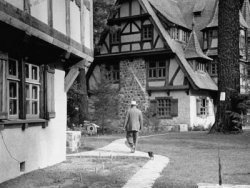 Hearst, dachshund, and castle substituteBut in 1933 the Depression caught up with Hearst. Money grew tight enough that work couldn't begin on the new venture. The stones sat patiently in their warehouse accruing storage costs. Business went from bad to worse until eventually Hearst realized he would never be able to build his medieval dream. He built at Wyntoon a less expensive "Bavarian Village" instead. (Again, I kid you not.) He tried selling the monastery stones but there were no takers. Storage costs kept accumulating.
Hearst, dachshund, and castle substituteBut in 1933 the Depression caught up with Hearst. Money grew tight enough that work couldn't begin on the new venture. The stones sat patiently in their warehouse accruing storage costs. Business went from bad to worse until eventually Hearst realized he would never be able to build his medieval dream. He built at Wyntoon a less expensive "Bavarian Village" instead. (Again, I kid you not.) He tried selling the monastery stones but there were no takers. Storage costs kept accumulating. Franco suggested the stones be returned to Spain. Hearst did not oblige. Finally, in 1941, Hearst presented the stones to the city of San Francisco as a gift with the understanding that the monastery would be reconstructed and made into a Museum of Medieval Arts right next to the DeYoung museum in Golden Gate Park. The city was thrilled! Plans for the museum were drawn up. In return for Hearst's generosity, San Francisco took care of the little problem of the $25,000 in outstanding storage debt. The stones were then carted to Golden Gate Park to await their transformation.
 Crated stones fire 1941 (SFPL photo)
Crated stones fire 1941 (SFPL photo)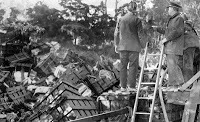 Stones on fire 1958 (SFPL photo)
Stones on fire 1958 (SFPL photo)But there were more bad years ahead for our stones. Money for the construction could not be raised. People disagreed where the museum should be built. The Board of Supervisors couldn't gather consensus for a bond issue. A government Park commission couldn't resolve the matter, and then a neutral citizen's commission failed to make headway. As the years passed and the stones sat in the park unprotected from the weather and vandalism, they endured five (count them, five!) fires, at least two of them arson. One wouldn't think stones would burn, but the heating and then sudden cooling by water as the fires were put out took their toll, fracturing some of the stones internally. Brambles grew over the stones strewn in unorganized piles. Some smaller ones were carried off altogether to parts unknown. By 1960 it was determined that only half of the stones were sound enough to use in construction.
 Stone graveyard?In the decade of Haight Ashbury's ascendance, the Recreation and Park Department was given responsibility for our poor forsaken stones. Someone practical decided to put the stones to use, and a number found their way into various gardens in the park, including the Arboretum and the Japanese Tea Garden. A few citizens still had the goal to at least rebuild the Chapter House of the monastery (a large room where meetings were held), but the price tag was now $3 million and funds never emerged.
Stone graveyard?In the decade of Haight Ashbury's ascendance, the Recreation and Park Department was given responsibility for our poor forsaken stones. Someone practical decided to put the stones to use, and a number found their way into various gardens in the park, including the Arboretum and the Japanese Tea Garden. A few citizens still had the goal to at least rebuild the Chapter House of the monastery (a large room where meetings were held), but the price tag was now $3 million and funds never emerged. 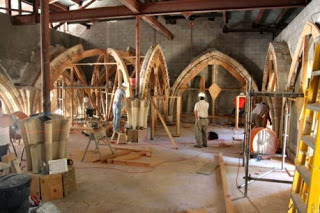 New homeIn the meantime, an order of Cistercian monks in Vina, California had a dream of reclaiming the stones for religious use—and for Cistercian religious use at that! They set their sights on rebuilding the Chapter House as a part of their own abbey. But they would have to be patient. It took thirty-nine years, from 1955 to 1994, before they finally convinced the Museum of Fine Arts in San Francisco to release the stones that remained of the Chapter House to them on permanent loan. There was public outcry in San Francisco at the decision ("The museum is giving away 'our' monastery!"), but the stones went to their new home nonetheless, and construction began at the Abbey of New Clairvaux. All these years later, the reconstruction is still underway (but almost finished!) if you're ever passing Vina, California (population 237) and want to see what a twelfth-century Chapter House of a medieval monastery looks like.
New homeIn the meantime, an order of Cistercian monks in Vina, California had a dream of reclaiming the stones for religious use—and for Cistercian religious use at that! They set their sights on rebuilding the Chapter House as a part of their own abbey. But they would have to be patient. It took thirty-nine years, from 1955 to 1994, before they finally convinced the Museum of Fine Arts in San Francisco to release the stones that remained of the Chapter House to them on permanent loan. There was public outcry in San Francisco at the decision ("The museum is giving away 'our' monastery!"), but the stones went to their new home nonetheless, and construction began at the Abbey of New Clairvaux. All these years later, the reconstruction is still underway (but almost finished!) if you're ever passing Vina, California (population 237) and want to see what a twelfth-century Chapter House of a medieval monastery looks like.  A portion of the rest of the stones can be found strewn throughout Golden Gate Park, especially in the Botanical Gardens. The Library Terrace Garden (near the Main gate) has a wall and seating area constructed from the stones, some of which were undoubtedly column capitals and other ornamentation. I also spotted some carved stones in the Fragrance Garden, and the Rhododendron Garden (most easily accessed from the North gate) boasts the architectural whimsy that first caught my notice.
A portion of the rest of the stones can be found strewn throughout Golden Gate Park, especially in the Botanical Gardens. The Library Terrace Garden (near the Main gate) has a wall and seating area constructed from the stones, some of which were undoubtedly column capitals and other ornamentation. I also spotted some carved stones in the Fragrance Garden, and the Rhododendron Garden (most easily accessed from the North gate) boasts the architectural whimsy that first caught my notice. 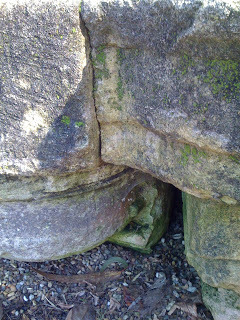 When the twelfth-century stonemasons put that monastery together, maybe they imagined their handiwork enduring centuries of weather as it sheltered monks and novitiates during the daily rituals of monastic life. Maybe the masons could even envision their stones facing fire and defilement. (Through war? Conquest?) But could they have dreamed that one of the richest and most powerful men in the world would take their stones to the other side of the planet for his personal pleasure? (Probably not given they didn't know the world was a sphere and had another side.) And could they have imagined a city filled with skyscrapers that would want their stones to make a monument dedicated to the craftsmanship and art of their era? Or that this grand city would fail in their quest and decorate their gardens with the stones instead? Or that, eight centuries after the stones were first cut, monks separated so far in time and space from their medieval brethren would patiently gather some of the stones and use them to again shelter monks and novitiates in the daily rhythms of monastic life?
When the twelfth-century stonemasons put that monastery together, maybe they imagined their handiwork enduring centuries of weather as it sheltered monks and novitiates during the daily rituals of monastic life. Maybe the masons could even envision their stones facing fire and defilement. (Through war? Conquest?) But could they have dreamed that one of the richest and most powerful men in the world would take their stones to the other side of the planet for his personal pleasure? (Probably not given they didn't know the world was a sphere and had another side.) And could they have imagined a city filled with skyscrapers that would want their stones to make a monument dedicated to the craftsmanship and art of their era? Or that this grand city would fail in their quest and decorate their gardens with the stones instead? Or that, eight centuries after the stones were first cut, monks separated so far in time and space from their medieval brethren would patiently gather some of the stones and use them to again shelter monks and novitiates in the daily rhythms of monastic life? The world spins and comes around, all in its own time. In the winter-spring sunshine, I sit on these stones carved so long ago, admire their soul, their beauty, and consider their grand journey through space and time.
Note: The Rhododendron Garden in the Botanical Garden is not the same as the Rhododendron Dell that is located east of the Academy of Sciences. (It is easy to confuse the two.)
Sources:
www.sacredstones.org
http://www.outsidelands.org/monastery-stones.php
Published on February 10, 2012 14:42
January 20, 2012
The Cruelties of Gilligan's Island, Hamlet and Chopin
 All boats carry Hamlet costumes in case of shipwreckMy introduction to both Hamletand the opera, Carmen, was through a Gilligan's Island episode--you know, theone where a movie producer crash lands his plane on the island with them. He sends out a distress call, so itlooks like at last help is on the way--hurrah! But, before the rescue, Gingerwants to convince the producer to cast her in one of his movies. So ourintrepid castaways come up with the brilliant (at least brilliant to all futurepop culture) idea to stage Hamlet setto tunes from Carmen. (And also, itturns out, from Offenbach's Tales ofHoffmann, but I just learned that.) The producer is impressed, so impressedthat he slinks away to be rescued without them so he can produce Hamlet, The Musical as his own originalidea. Poor islanders, foiled again.
All boats carry Hamlet costumes in case of shipwreckMy introduction to both Hamletand the opera, Carmen, was through a Gilligan's Island episode--you know, theone where a movie producer crash lands his plane on the island with them. He sends out a distress call, so itlooks like at last help is on the way--hurrah! But, before the rescue, Gingerwants to convince the producer to cast her in one of his movies. So ourintrepid castaways come up with the brilliant (at least brilliant to all futurepop culture) idea to stage Hamlet setto tunes from Carmen. (And also, itturns out, from Offenbach's Tales ofHoffmann, but I just learned that.) The producer is impressed, so impressedthat he slinks away to be rescued without them so he can produce Hamlet, The Musical as his own originalidea. Poor islanders, foiled again.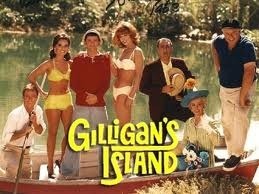 My childhood speaksGilligan's Islandran from 1964 to 1967. This astonishes me because it means that during the70's, when I saw it, I only ever viewed it in reruns. (In between Bewitched and I Love Lucy episodes. Oh that Desi.) And, boy, did I view it. Gilligan's Island was a staple of mychildhood. I must have seen every episode at least three times, especiallyduring the long rainy Seattle summer afternoons when only reruns filled theairwaves. Television had enormous power and influence on me during those years.To say it was my window on the world is a vast understatement. What anastonishing use of my time and childhood.
My childhood speaksGilligan's Islandran from 1964 to 1967. This astonishes me because it means that during the70's, when I saw it, I only ever viewed it in reruns. (In between Bewitched and I Love Lucy episodes. Oh that Desi.) And, boy, did I view it. Gilligan's Island was a staple of mychildhood. I must have seen every episode at least three times, especiallyduring the long rainy Seattle summer afternoons when only reruns filled theairwaves. Television had enormous power and influence on me during those years.To say it was my window on the world is a vast understatement. What anastonishing use of my time and childhood. Matches the shagI grew up in a classic, brand new subdivision rifewith young families and children where every house was decorated in HarvestGold or Avocado Green. Your choice of color would determine the shade of yourshag carpet, appliances and panel of hideous frosted glass located next to yourfront door. I'm sorry to remind you that this is how many of us lived in the70's, I truly am. I just spent five minutes looking at photos of ugly 70'skitchens, and it is more depressing than I can say.
Matches the shagI grew up in a classic, brand new subdivision rifewith young families and children where every house was decorated in HarvestGold or Avocado Green. Your choice of color would determine the shade of yourshag carpet, appliances and panel of hideous frosted glass located next to yourfront door. I'm sorry to remind you that this is how many of us lived in the70's, I truly am. I just spent five minutes looking at photos of ugly 70'skitchens, and it is more depressing than I can say.In this classic, hastily-built subdivision there were threechoices of floor plan—rambler, tri-level or split level. Every friend's homeyou went into you knew where to find the bathroom because you'd already been inthree other houses exactly (and I mean exactly)like it. Even as a child I knew this was wrong, that I was living in anarchitectural wasteland. My subdivision was named "Wellington." I assume thiswas after the Duke of Wellington, defeater of Napoleon, victor of Waterloo. Icould weep.
 For the rambling manMy house was of the rambler variety. Three bedrooms, two baths. It looked something like the photo to the right, exceptit was brownish-olive-brown in color.Brown was very seventies. Peoplewore brown, decorated with brown, and had lots and lots of brown hair. Menhad brown moustaches and sported brown sideburns. People began to eat brownbread and macramé brown hanging plant holders with brown jute that would holdbrown plants once the poor things died.
For the rambling manMy house was of the rambler variety. Three bedrooms, two baths. It looked something like the photo to the right, exceptit was brownish-olive-brown in color.Brown was very seventies. Peoplewore brown, decorated with brown, and had lots and lots of brown hair. Menhad brown moustaches and sported brown sideburns. People began to eat brownbread and macramé brown hanging plant holders with brown jute that would holdbrown plants once the poor things died. No mowingMy father didn't want to mow grass (he had allergies), so hecovered our front yard in rocks. It looked a little like the photo to the left, except, well, less attractive. But I do admire his willingness to experiment. Every other yard in the entire 80-housesubdivision had a freaking lawn. We were the strange ones.
No mowingMy father didn't want to mow grass (he had allergies), so hecovered our front yard in rocks. It looked a little like the photo to the left, except, well, less attractive. But I do admire his willingness to experiment. Every other yard in the entire 80-housesubdivision had a freaking lawn. We were the strange ones.Though I didn't read Hamletuntil my freshman year of college, it must've been sometime during thepurgatory just this side of hell known as junior high that it dawned on me thatthe play in the Gilligan's Islandepisode was a highly abridged version of one of the greatest works in theEnglish language. The source of most of the episode's tunes probably didn'toccur to me until I studied opera during my junior year abroad and saw Carmen for the first time in Florence.
 Now, though I love Carmen,I'm not a huge fan of Hamlet; he'stoo petty and indecisive for me.(He was the son of the king, for crying out loud. His rightful throne was usurped. Why theheck didn't he get some nobles together and chase his uncle out of Denmark?) Twelfth Night, Merchant of Venice and TheTempest are my favorites of Shakespeare's plays, and I've got a soft spotfor Romeo and Juliet. But Gilliganwill forever whisper in my ear (to the melody of the Habeneraaria), "To fight or flee, to fight or flee. I ask myself to be or not tobe?"
Now, though I love Carmen,I'm not a huge fan of Hamlet; he'stoo petty and indecisive for me.(He was the son of the king, for crying out loud. His rightful throne was usurped. Why theheck didn't he get some nobles together and chase his uncle out of Denmark?) Twelfth Night, Merchant of Venice and TheTempest are my favorites of Shakespeare's plays, and I've got a soft spotfor Romeo and Juliet. But Gilliganwill forever whisper in my ear (to the melody of the Habeneraaria), "To fight or flee, to fight or flee. I ask myself to be or not tobe?"So two of the heavyweights of the Western canon were introducedto me by the likes of Lovey and Thurston Howell the Third. Faux, ersatz, a parodybefore I had any idea of what was being parodied. Did my culture value me solittle or the works so little that I was fed the spoof rather than the realthing? I guess it could've been worse. No doubt children these days miss nary a classic via The Simpsons.
 PusherBut Chopin—Chopin was different. He didn't come through the back door. He was introduced tome as he ought to have been--whole, genuine, the real thing--straight into mysoul via the ephemeral elegance of ballet.
PusherBut Chopin—Chopin was different. He didn't come through the back door. He was introduced tome as he ought to have been--whole, genuine, the real thing--straight into mysoul via the ephemeral elegance of ballet.Trapped in my seventies subdivision, attending a school that mostly bored me to tears, my onesaving grace, besides reading a book a day, was ballet lessons. I took ballet at first twice a week,then three times, then pretty much most of Saturday added as well. And Chopinwas the music of the barre, of the center floor, of the porte de bras. Yes, histempo was often altered slightly so my teacher, Mrs. Bruce, could sternly count, "And one, and two, and three, and four," but it was still him directlyresponsible for the rippling notes.
 A young girl's heroinBallet! Not only did I get introduced to Giselle, Swan Lake, The Nutcracker, and LesSylphides, but also art, because one Christmas Mrs. Bruce gave usall posters of dancers by Impressionists (Degas! Renoir!) as gifts. Mine was this beauty on the right. She was on my bedroom wall until I wentaway to college. And classical music! Tchaikovsky, of course; but also Ravel, Liszt,Saint-Saens, and a host of others. (But not Beethoven. I became acquainted withhim later.) It was rapture, euphoria, cultural heroin. Like having two hundredyears of European civilization injected straight into my veins. I was hooked, ajunkie for life. No wonder I loved ballet fiercely for five years even though Ididn't have the body for it. (I had no turn out, my legs and feet just wouldn'tdo 180 degrees, and classical ballet is cruel, cruel, cruel. You have the bodyor you don't. After the body, then comes talent, determination, lyricism, andeffort. But the body comes first.)
A young girl's heroinBallet! Not only did I get introduced to Giselle, Swan Lake, The Nutcracker, and LesSylphides, but also art, because one Christmas Mrs. Bruce gave usall posters of dancers by Impressionists (Degas! Renoir!) as gifts. Mine was this beauty on the right. She was on my bedroom wall until I wentaway to college. And classical music! Tchaikovsky, of course; but also Ravel, Liszt,Saint-Saens, and a host of others. (But not Beethoven. I became acquainted withhim later.) It was rapture, euphoria, cultural heroin. Like having two hundredyears of European civilization injected straight into my veins. I was hooked, ajunkie for life. No wonder I loved ballet fiercely for five years even though Ididn't have the body for it. (I had no turn out, my legs and feet just wouldn'tdo 180 degrees, and classical ballet is cruel, cruel, cruel. You have the bodyor you don't. After the body, then comes talent, determination, lyricism, andeffort. But the body comes first.)Eventually I gave up on ballet after glimpsing that thisrarefied, mysterious world wonderfully far from shag rugs and television laugh tracks might also beaccessible through literature and college. Chopin's music still beckoned, so enigmatic and sublime. Life would be a glorious wonder if only entry into his universe could be obtained.
 Suburban soul foodThere are cruelties and there are cruelties. Ballet ismerciless. It knows its enchantment and demands everything of you that can begiven. It is so heartless it can turn away emaciated orphans from its doorwithout a twinge of regret. Gilligan'sIsland in comparison was a TV dinner cook. Its intentions were no doubtbenign enough, but when I was literally starved for culture, it fed me Twinkiesand Cheez-Whiz.
Suburban soul foodThere are cruelties and there are cruelties. Ballet ismerciless. It knows its enchantment and demands everything of you that can begiven. It is so heartless it can turn away emaciated orphans from its doorwithout a twinge of regret. Gilligan'sIsland in comparison was a TV dinner cook. Its intentions were no doubtbenign enough, but when I was literally starved for culture, it fed me Twinkiesand Cheez-Whiz.But Chopin, it turns out, was the cruelest of all. Yes, hefed my soul when I had little else to sustain me, and yes, I still hear tracesof that magic world (secret garden?) as I play his notes on my piano. Butthere is never a final passageway to enter, no key to turn in the last lock. Yes, the floating preludes, the hushed nocturnes, the soaring waltzes limn themysteries of the human experience. They allude (so delicately!) to the vast,lost chambers in our souls we long for but never visit because we've forgottenhow or never knew the path. But his music promises what might be, not what is. Andit's not a promise that it keeps.
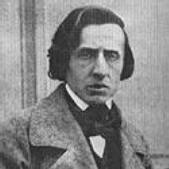 Did he promise a rose garden?Perhaps this isn't Chopin's fault. Perhaps he just glimpsed these worlds, too, and the best hecould do was communicate potential, not define how to achieve it. Perhaps,indeed, sensing a plane of consciousness askew to our own, one just out ofreach, that we catch sight of only from the corner of our eye or in a fleeting run of notes, is an immutablepart of being human (transcended by a few lamas and saints.) We get the moments, the glimpses, andmust bear it best we can. Even if it means we live out a Gilligan's Island version of Hamlet.
Did he promise a rose garden?Perhaps this isn't Chopin's fault. Perhaps he just glimpsed these worlds, too, and the best hecould do was communicate potential, not define how to achieve it. Perhaps,indeed, sensing a plane of consciousness askew to our own, one just out ofreach, that we catch sight of only from the corner of our eye or in a fleeting run of notes, is an immutablepart of being human (transcended by a few lamas and saints.) We get the moments, the glimpses, andmust bear it best we can. Even if it means we live out a Gilligan's Island version of Hamlet.
Published on January 20, 2012 19:57
January 5, 2012
Ulysses S. Grant--Out of Love But Still Very Fond
 The ManThis a sequel to my previous post,
I Am In Love With Ulysses S. Grant
, written just as I began the perusal of his memoirs.
The ManThis a sequel to my previous post,
I Am In Love With Ulysses S. Grant
, written just as I began the perusal of his memoirs.Ah, Ulysses. Hiram Ulysses, actually. During his appointmentto West Point, his middle name got mixed up as his first, and when he got tothe Academy, he didn't argue about it. Sign of a good solider, I suppose, takewhat comes. Put up and shut up.Except Grant's genius was that during the Civil War, "do what you'retold" was not what he did.
Grant was a math guy. In the Mexican-American War he was aquartermaster—the officer in charge of supplies, rations, clothing, and shelter. Though I still don't understand howsomeone good at supplying an army (and later commanding an army) could be sohideously bad at running a small business as Grant, his memoirs show thatlogistics was indeed a key strength. He was always considering how to getsupplies to his army or cut them off from the enemy, either by choking offsupply routes or destroying the supplies themselves. (Sometimes the enemy'ssupplies were still in the fields and smokehouses of the Confederate citizenry.As Grant saw it, this was what Sherman's march to the sea was all about.) Lookingat the state of Lee's army at Appomattox, this strategy appears to have worked,though the terrible casualties, the noose of Grant's forces preventing escape, and the desertions due to low morale no doubtcontributed as well.
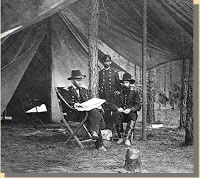 Raring to vanquishGrant's other great strength was his tremendous impatience,almost fury, to trounce his opponents. While out west, often cut off from communication with Washington and hishigher ups, Grant took the initiative and attacked when and where he thought hecould win. (When your superiors are terrified to act for fear of blame, doingfirst and informing later is an effective tactic as long as the result is asuccess that your superiors can take credit for.) He rose through the ranks through sheer nerve and competence when such qualities were scarce.
Raring to vanquishGrant's other great strength was his tremendous impatience,almost fury, to trounce his opponents. While out west, often cut off from communication with Washington and hishigher ups, Grant took the initiative and attacked when and where he thought hecould win. (When your superiors are terrified to act for fear of blame, doingfirst and informing later is an effective tactic as long as the result is asuccess that your superiors can take credit for.) He rose through the ranks through sheer nerve and competence when such qualities were scarce.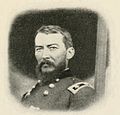 Go-Getter SheridanOnce Grant was promoted to general-in-chief of all theFederal forces and had to operate out of the east, you could palpably feel hisfrustration with the idiotic interference of Stanton and Halleck (be cautious!be defensive!) who would change Grant'sdirect orders without his knowledge. And you can understand his vexationwhen his subordinates failed to follow orders or followed them too late to beof use. Grant loved Sherman and Sheridan because they could get their men marchingoff before most other commanders could put one leg out of bed.
Go-Getter SheridanOnce Grant was promoted to general-in-chief of all theFederal forces and had to operate out of the east, you could palpably feel hisfrustration with the idiotic interference of Stanton and Halleck (be cautious!be defensive!) who would change Grant'sdirect orders without his knowledge. And you can understand his vexationwhen his subordinates failed to follow orders or followed them too late to beof use. Grant loved Sherman and Sheridan because they could get their men marchingoff before most other commanders could put one leg out of bed.Reading the memoirs I was amazed at how often the Federal troopsmade very early morning (3:30 am!) or all night marches. In the west, Grant wasoften able to use his predilection for early movement to surprise his opponent.It worked less well with Lee because Lee started doing it, too. Perhaps Lee heard about Grant's tacticsin the western battles and adjusted accordingly?
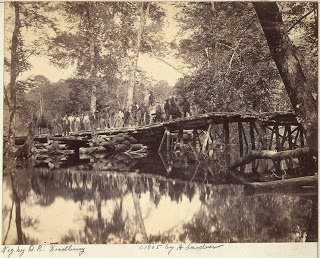 Hasty military bridge--Chickahominy, Virginia
Hasty military bridge--Chickahominy, Virginia
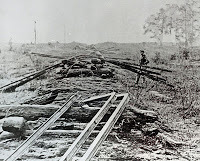 Cut those supply linesAnother aspect of the war that astounded me was how oftenrailroads were ripped up and then laid right back down. To disrupt the otherside's supply lines and troop transport, each army had a small army constantlyburning ties and twisting rails into curlicues. Then when the otherside gained back control of the area, they would put down new ties and unbendthe steel. Bridges were alsoconstantly destroyed and rebuilt, although Grant's army did often carry aroundpontoons with them to get over rivers in a pinch. And all this was doneincredibly rapidly, without backhoes, chainsaws or cranes.
Cut those supply linesAnother aspect of the war that astounded me was how oftenrailroads were ripped up and then laid right back down. To disrupt the otherside's supply lines and troop transport, each army had a small army constantlyburning ties and twisting rails into curlicues. Then when the otherside gained back control of the area, they would put down new ties and unbendthe steel. Bridges were alsoconstantly destroyed and rebuilt, although Grant's army did often carry aroundpontoons with them to get over rivers in a pinch. And all this was doneincredibly rapidly, without backhoes, chainsaws or cranes.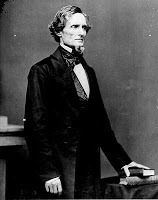 LoathedThough I still admire Grant, I have to say my infatuationhas faded, as infatuations are wont to do. He was more of a black-and-white guythan I like, though I realize seeing the grey in things does not a good generalmake. In a war, there are only two sides: yours and the enemy's. Grant wasclear why he was fighting, what needed to be done, and what sacrifices wereworth making. Though he didn't like his men dying, he accepted the deaths and maimingas the cost of winning. He acknowledged the valor and tenacity of theConfederates but believed them wrong, wrong, wrong. He respected Lee, admired Lincoln (though pooh-poohed him when he put his pretty civilian head towards military strategy) and despised theConfederate president, Jefferson Davis.
LoathedThough I still admire Grant, I have to say my infatuationhas faded, as infatuations are wont to do. He was more of a black-and-white guythan I like, though I realize seeing the grey in things does not a good generalmake. In a war, there are only two sides: yours and the enemy's. Grant wasclear why he was fighting, what needed to be done, and what sacrifices wereworth making. Though he didn't like his men dying, he accepted the deaths and maimingas the cost of winning. He acknowledged the valor and tenacity of theConfederates but believed them wrong, wrong, wrong. He respected Lee, admired Lincoln (though pooh-poohed him when he put his pretty civilian head towards military strategy) and despised theConfederate president, Jefferson Davis. In the first half of Grant's accounts, before he becamecommander-in-chief of the Northern army, I got more of a sense of thoughtfulness,more wry acknowledgement of the twists and turns that fate throws us mortals. Perhapsin the second half Grant became more cut and dried because he was growing veryill and felt the need to make the case for his version of history before histime was up. He seemed defensive that people claimed Lee was the bettergeneral, he didn't really acknowledge the terrible destruction done to theSouth by Sherman and other Northern forces or later during the Reconstruction.(He doesn't go much into his presidency at all.) He sincerely believed slavery was wrong but didn't mentionthat both he and his wife owned slaves for a time. He didn't believe in socialequality between blacks and whites.
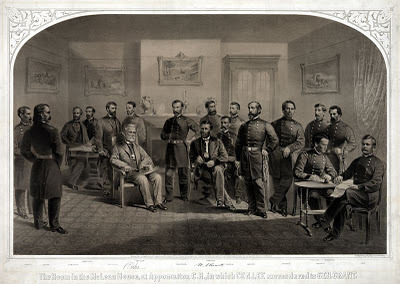 The Surrender
The SurrenderGrant was a great general who rose through the ranks of theNorthern army because no one else could or would do the job in an even halfwayeffective fashion. Since he wasn't a political appointee or career military, hehad little to lose in terms of salary or position and so was willing to takerisks. Poor, poor Lincoln to have such miserable, patheticgenerals who refused to do much of anything. Grant was so young, only 41, whenhe became commander-in-chief. This in itself is a measure of how desperateLincoln was. There is anhysterical telegram from Lincoln (in Washington) to Grant (on the battlefields)that beautifully sums up what Lincoln was going through:
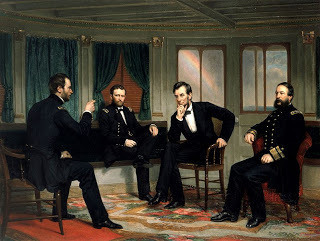 "The Peacemakers"--Sherman, Grant, Lincoln, Porter"I have seen your despatch in which you say 'I want Sheridanput in command of all the troops in the field, with instructions to put himselfSouth of the enemy, and follow him to the death. Wherever the enemy goes, letour troops go also.' This I think, is exactly right, as to how our forcesshould move. But please look over the despatches you may have received fromhere, even since you made that order, and discover, if you can, that there isany idea in the head of any one here, of 'putting our army South of the enemy' or of following him 'to the death' in any direction. I repeat to youit will neither be done nor attempted unless you watch it every day, and hour,and force it."
"The Peacemakers"--Sherman, Grant, Lincoln, Porter"I have seen your despatch in which you say 'I want Sheridanput in command of all the troops in the field, with instructions to put himselfSouth of the enemy, and follow him to the death. Wherever the enemy goes, letour troops go also.' This I think, is exactly right, as to how our forcesshould move. But please look over the despatches you may have received fromhere, even since you made that order, and discover, if you can, that there isany idea in the head of any one here, of 'putting our army South of the enemy' or of following him 'to the death' in any direction. I repeat to youit will neither be done nor attempted unless you watch it every day, and hour,and force it."Basically Lincoln is flat out telling Grant that everyone associated with the war in Washington was a useless, incompetent viper and that he himself couldn't do much about it.
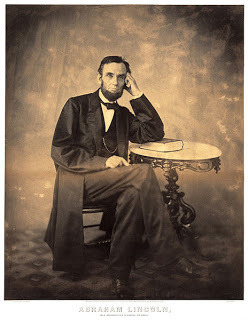 What might he have done?Grant wasn't a man who had the patience or finesse forpolitics, and he was inclined to assume people would follow orders correctlyrather than suspect they would screw up (which happened with dishearteningfrequency.) He seemed to feel that since Southerners caused the war theydeserved a certain amount of retribution—especially South Carolina. Heindicated that President Johnson's accommodations of the South immediatelyafter the war were what prompted the drastic measures of the Reconstruction.From everything he writes of Lincoln, it is indeed a great tragedy that Lincolnwas assassinated. Lincoln was the one man who would've had the patience, compassion, political skill, and credibility to knit North and Southback together with an even hand. Reconstruction certainly made advances forAfrican Americans and gave them a brief spot in the sun in terms of politicalpower, but all those advances were soon washed away and replaced by a heavy handfor over a hundred years. Less retribution, more healing, and a firm commitmentto education, economic opportunity, and enfranchisement of African Americansover the long haul would have been so much better.
What might he have done?Grant wasn't a man who had the patience or finesse forpolitics, and he was inclined to assume people would follow orders correctlyrather than suspect they would screw up (which happened with dishearteningfrequency.) He seemed to feel that since Southerners caused the war theydeserved a certain amount of retribution—especially South Carolina. Heindicated that President Johnson's accommodations of the South immediatelyafter the war were what prompted the drastic measures of the Reconstruction.From everything he writes of Lincoln, it is indeed a great tragedy that Lincolnwas assassinated. Lincoln was the one man who would've had the patience, compassion, political skill, and credibility to knit North and Southback together with an even hand. Reconstruction certainly made advances forAfrican Americans and gave them a brief spot in the sun in terms of politicalpower, but all those advances were soon washed away and replaced by a heavy handfor over a hundred years. Less retribution, more healing, and a firm commitmentto education, economic opportunity, and enfranchisement of African Americansover the long haul would have been so much better.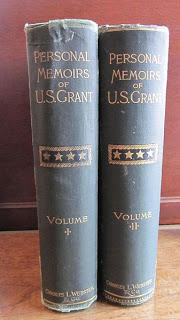 Are Grant's memoirs a literary masterpiece? Well, they have immense value and are, byand large, highly readable. They're more oriented towards military history thanI had expected (though he does spend time on his childhood and cadet years) andmy eyes did glaze over from time to time as each creek, swamp and bayou crossedwas discussed in detail. Even so I got a lot out of the work. Grant's voicespeaks to us from another place and time with a freshness that is remarkable. ThoughI don't know if he was always honest with himself (he never mentions hisdrinking), he does write with a candor and integrity I have rarely found inmemoirs. I got a great sense of what it was like to be him, in his shoes,directing troops, fretting about an enemy's retreat or how to feed the army's horsesbefore the grass is growing again in the spring. I love how after a week of battle he found a borrowed change of cleanunderwear extremely pleasant; I wonder at how he only mentions in passing that his son nearly diedof illness while he was holding Vicksburg under siege.
Are Grant's memoirs a literary masterpiece? Well, they have immense value and are, byand large, highly readable. They're more oriented towards military history thanI had expected (though he does spend time on his childhood and cadet years) andmy eyes did glaze over from time to time as each creek, swamp and bayou crossedwas discussed in detail. Even so I got a lot out of the work. Grant's voicespeaks to us from another place and time with a freshness that is remarkable. ThoughI don't know if he was always honest with himself (he never mentions hisdrinking), he does write with a candor and integrity I have rarely found inmemoirs. I got a great sense of what it was like to be him, in his shoes,directing troops, fretting about an enemy's retreat or how to feed the army's horsesbefore the grass is growing again in the spring. I love how after a week of battle he found a borrowed change of cleanunderwear extremely pleasant; I wonder at how he only mentions in passing that his son nearly diedof illness while he was holding Vicksburg under siege.Was he a great man? I believe so, though some of this wasdue entirely to his unique response to a unique demand of history. Was hemoral? I would say close, but since I have a few reservations he doesn't quitewin the cigar for that in my estimation. Do I know all his demons, did I plumbhis soul? Unfortunately, no. The memoirs don't go that far, and I can't say Iblame Grant for his reticence. Whowants their soul plumbed a hundred and thirty years after they've leftthe earth? But he left us his voice, his intelligence, and his understanding of his place in history, and I am glad to know the man and my country better because of it.
Published on January 05, 2012 11:21



